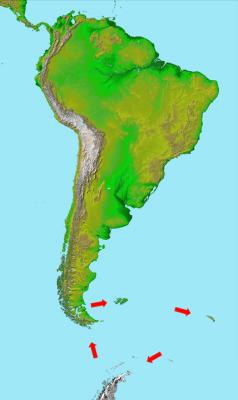
For Context ... |
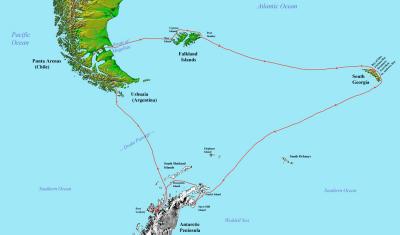
- Detailed Map - |
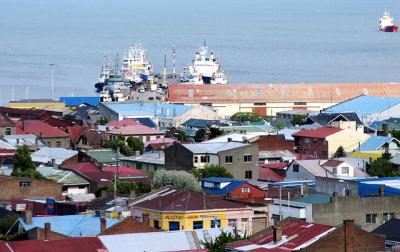
Our port of embarcation; M.S. Endeavour is at the pier on the right. |
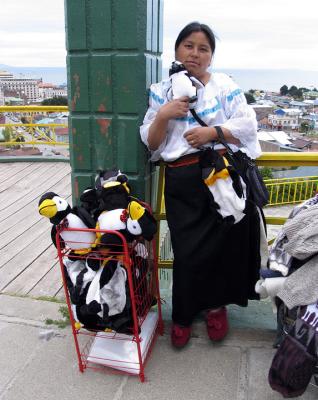
The only penguins with bow ties that we would meet. |
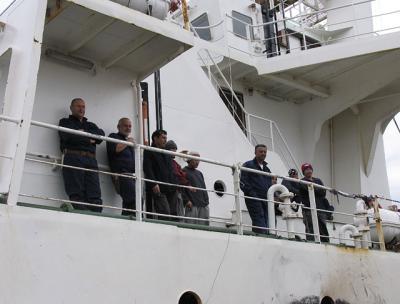
The crew of the rust-streaked Cabo de Hornos look on, bemused, as across the pier . . . |
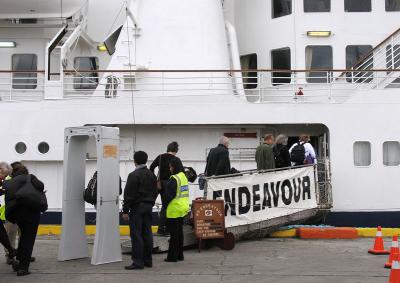
. . . the "Bristol-fashion" Endeavour boards its passengers. |
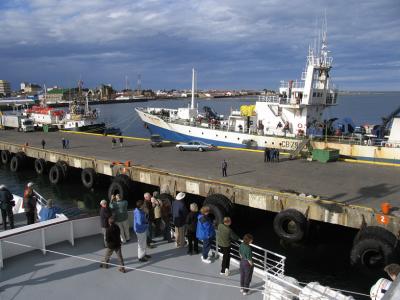
Pulling away from the pier. |
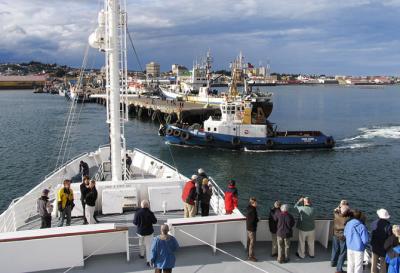
Endeavour, now under way, clears its harbor tug, Chan Chan, for other work. |
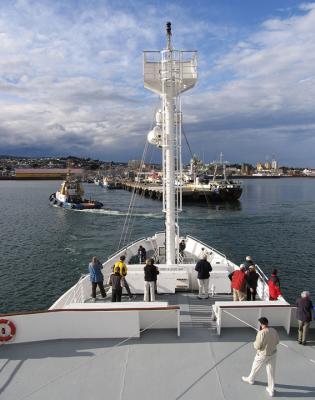 |
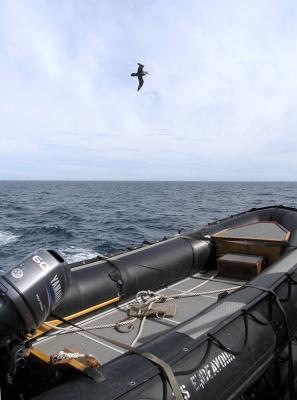
A lone giant petrel followed the ship. |
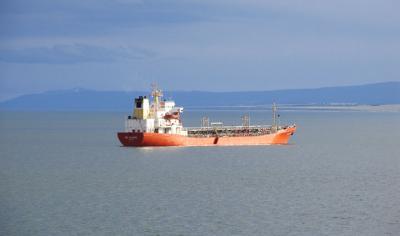
Free of the Strait of Magellan and at sea at last. |
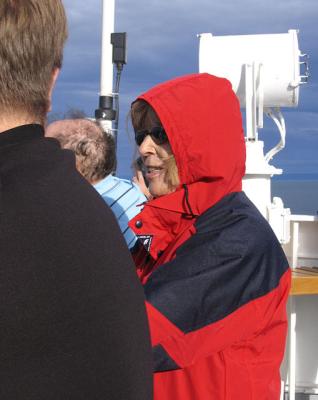
Shirtsleeve weather found only Dee and Jean "suited up." |
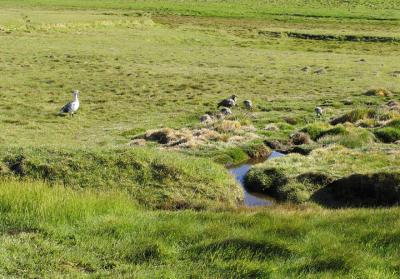
A family of upland geese. |
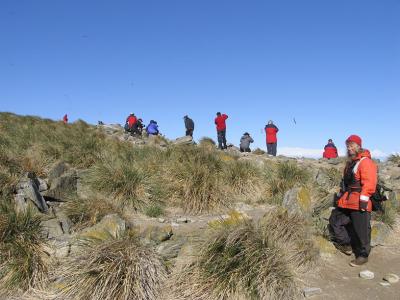
A penguin corral, from the "bad old days." |
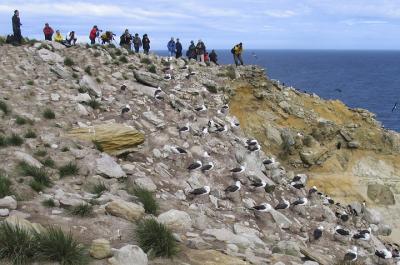
Black-browed albatrosses nest here late each year. |
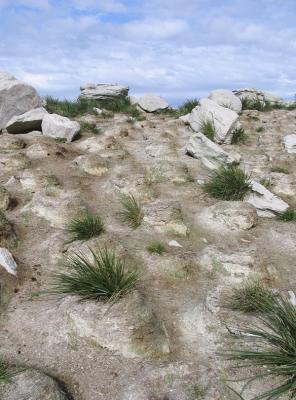
Tussock grass -- we'll see a lot of this. |
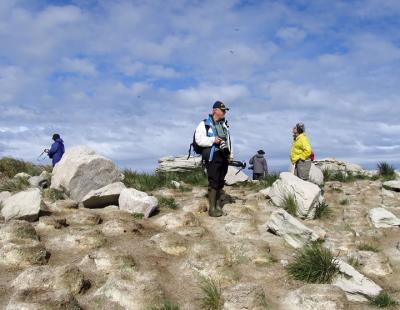
Albatrosses aloft are out zoom lens range, for the moment. |
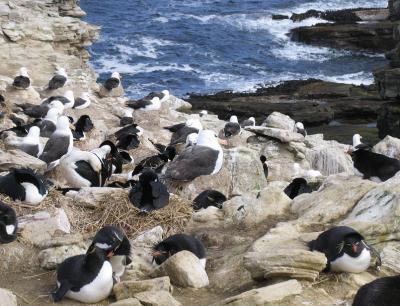
Larger albatross and cormorant neighbors protect the small rockhopper penguin from predators. |
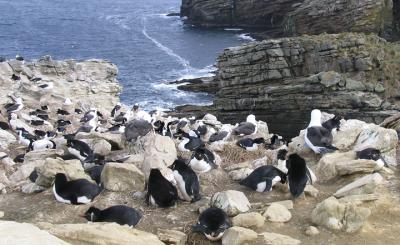
The rockhoppers hop up these cliffs one stone (or foothold) at a time, to reach their nests of stone and grass. |
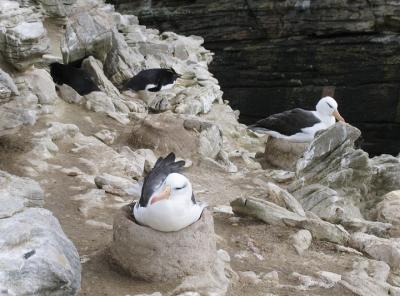
The black-browed albatross prefers a nest-cone of mud and grass. |
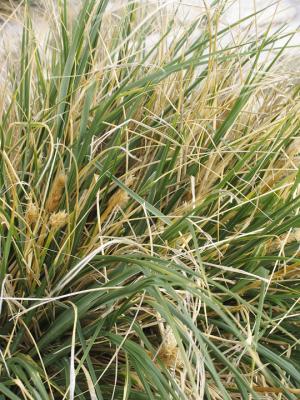 |
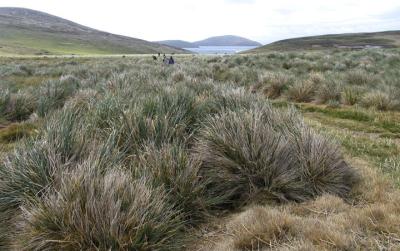
Salt-laden westerly winds leave the Falklands nearly treeless. |
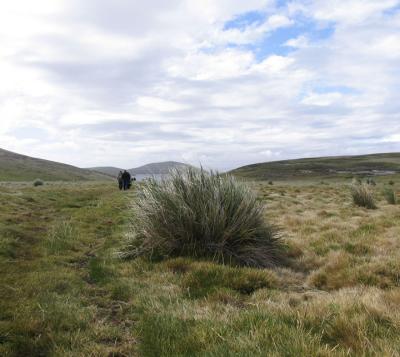 |
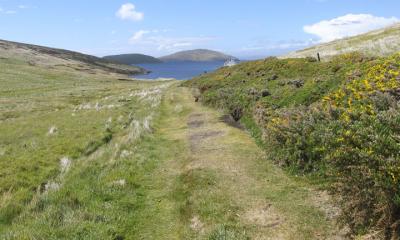
Two introduced species -- gorse and rabbits -- have become pests here. |
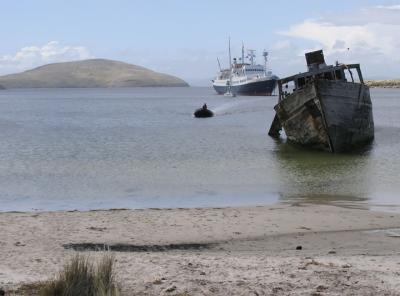
Rush hour on New Island: abandoned fishing vessel, Zodiac, yacht, and Endeavour, bumper to bumper. |
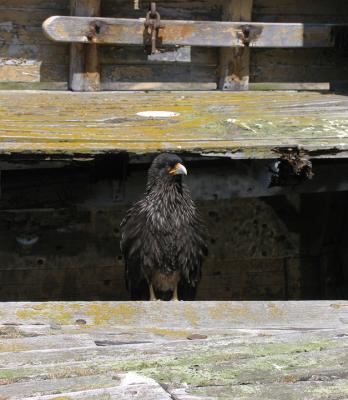
The striated caracara--"Johnny Rook"--is the scavenger of the Falklands. |
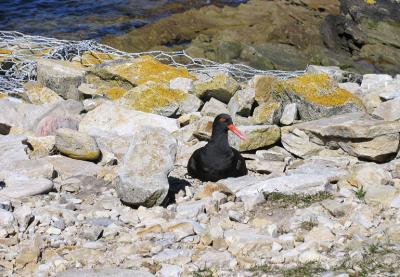
A nesting blackish oystercatcher eyed us calmly as we landed. |
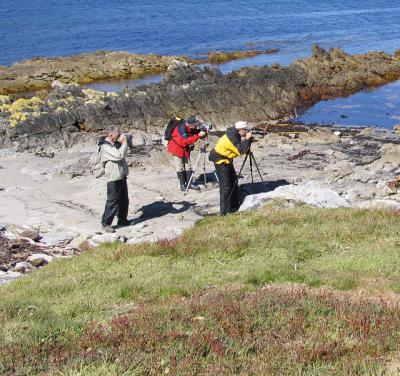
Serious photographers poised for action. |
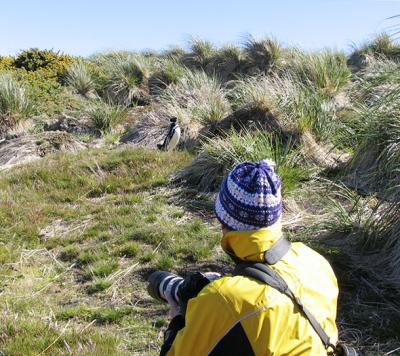
This Magellenic gentleman is having none of it and is returning to his burrow. |
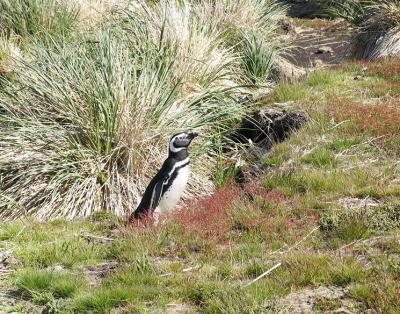
But not before Jean nabs him. |
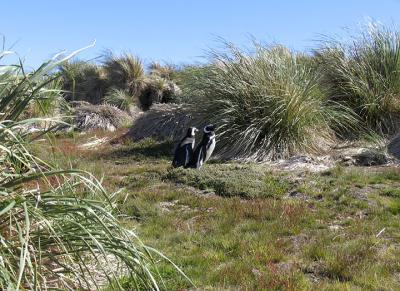
These two -- also Magellenic penguins -- were a bit more social. |
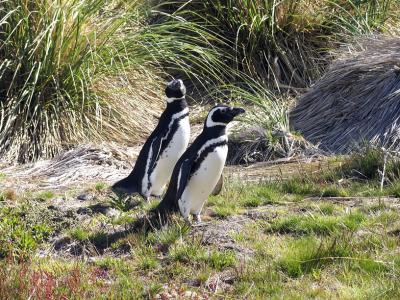
"What do you suppose it is?" "I don't know, but that red coat has to go!" |
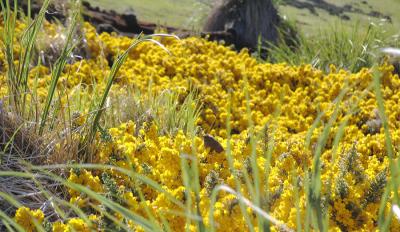
A Cobb's wren, one of a pair nesting in the gorse. |
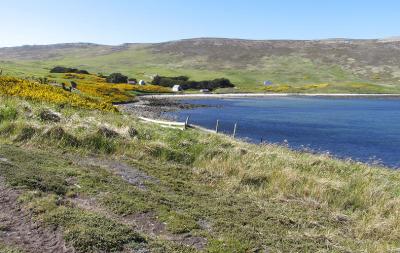
Rob and Lorraine McGill, the island's owners, receive guests at their farm. |
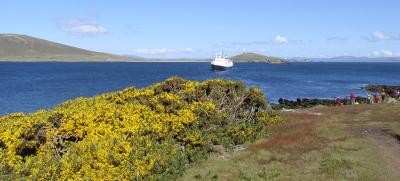
Though the name seems ominious, Carcass was named for a British warship. |
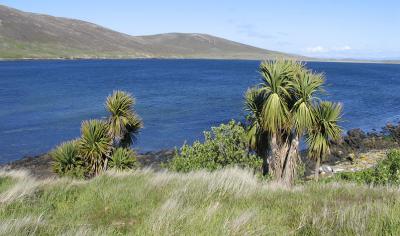 |
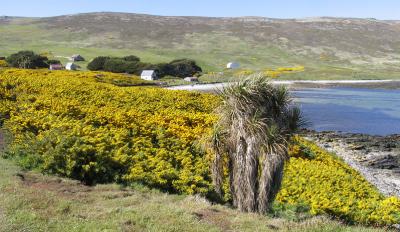 |
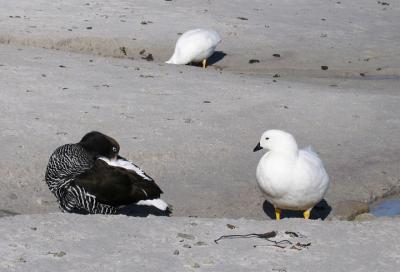
Kelp geese -- two males and a female -- on the beach below the farm house. |
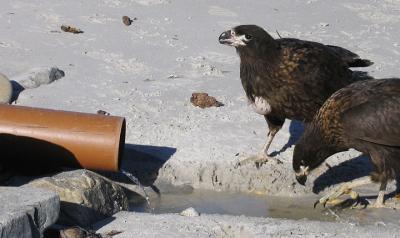
Two Johnny Rooks live up to their reputations as scavengers. |
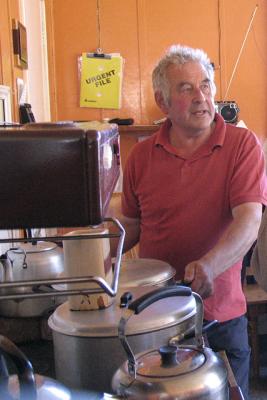
Our host, Rob McGill. |
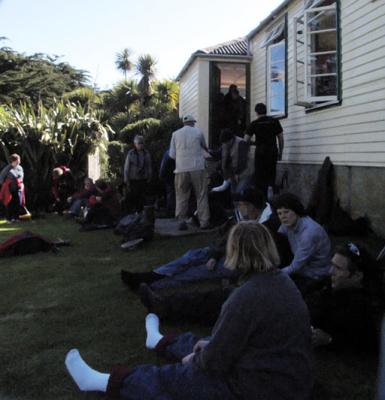
After a satisfying "farmer's tea," shipmates relax in the McGill garden. |
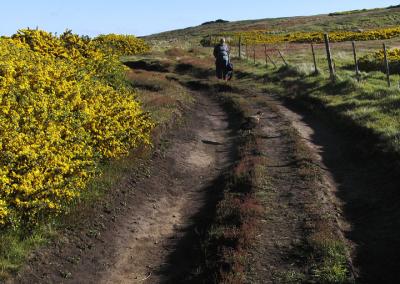
This could be a road across the English moors, except for the Johnny Rook enjoying a dust bath. |
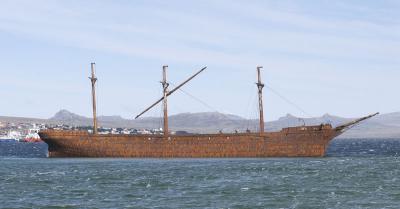
The barque Lady Elizabeth, built in England in 1879 - |
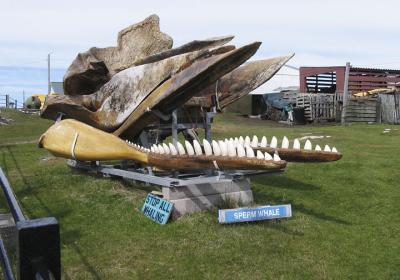
Artifiacts of a whaling past, that dates back to the mid-1700s. |
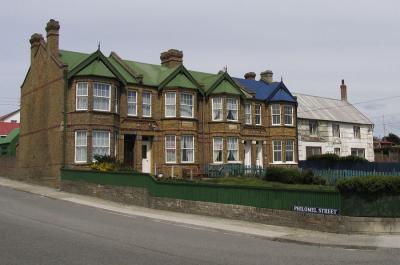
British row houses of the South Atlantic. |
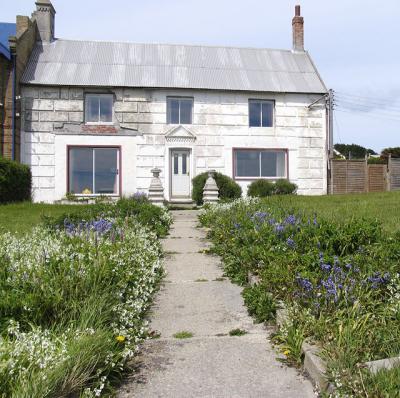 |
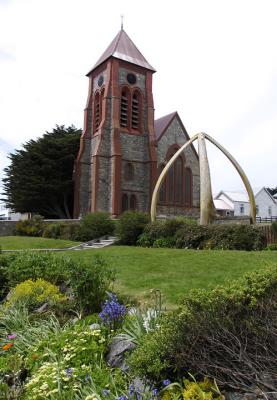
Christ Church Cathedral (Church of England, 1892) is known for its arch, made from the jaw bones of a blue whale. |
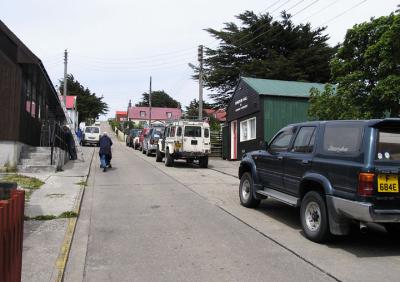
The vehicles of choice for Stanley's 2,000 residents seem to be Land Rovers and SUVs, - |
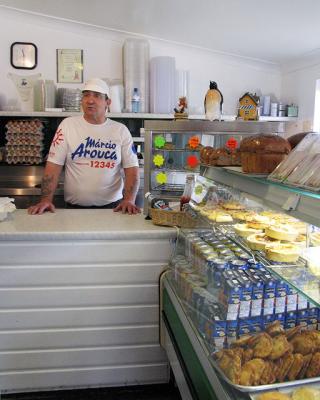
The British proprietor of The Bakery proudly sells empenadas and pizza as well as steak-and-kidney pies. |
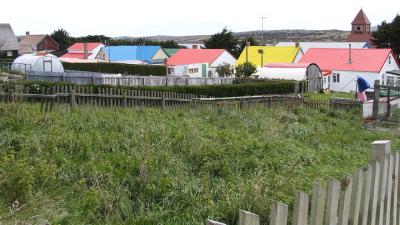
Colorful tin roofs brighten the landscape. With no trees and unworkable granite, all building materials must be imported. |
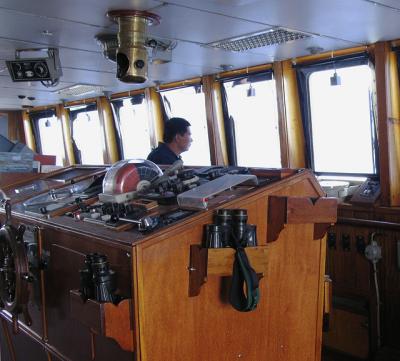
The bridge. One of the able-bodied seamen (ABs) on watch - |
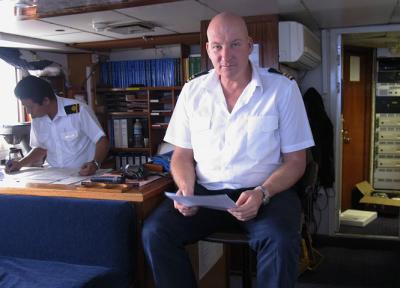
Aft station on the bridge, with radio shack beyond. |
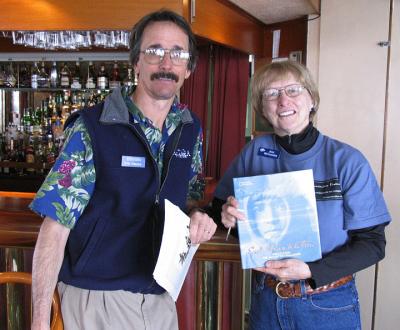
Lecturer Kim Heacox gave a talk based on his biography of Ernest Shackleton (Washington: National Geographic, 1999). |
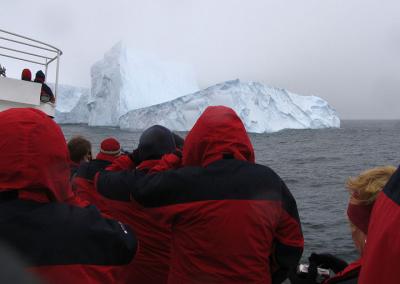
"All photographers on deck" for our first ice bergs. |
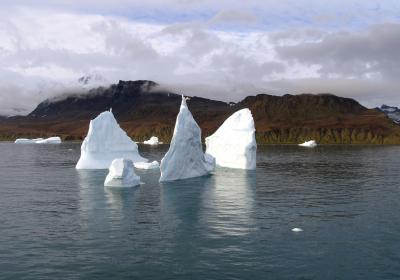
Ice sails, pieces of the former Larsen Ice Shelf. |
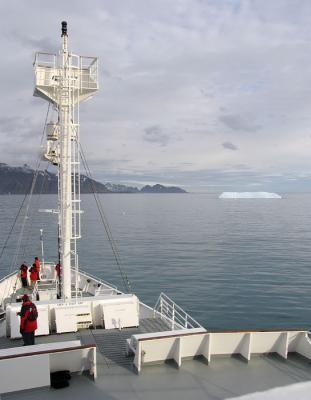
Approaching Grytviken ("Try-Pot"). |
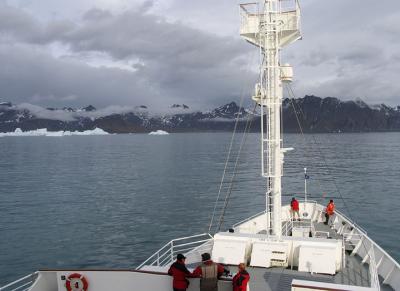
In 1775, Captain James Cook claimed South Georgia for England, naming it for George III. |
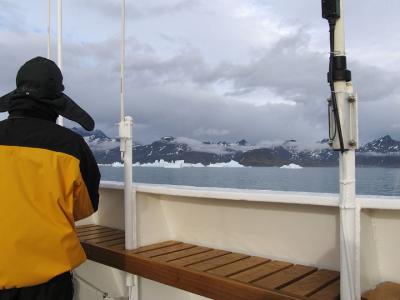
The view from Endeavor's "flying bridge." |
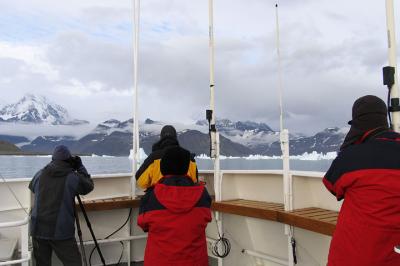 |
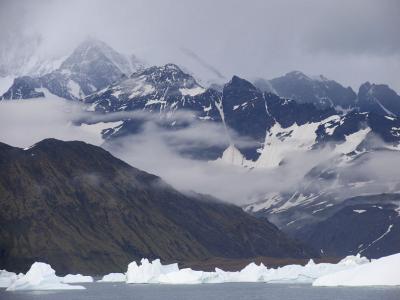
To save his men, an exhausted Ernest Shackleton crossed these mountains in 36 hours, - |
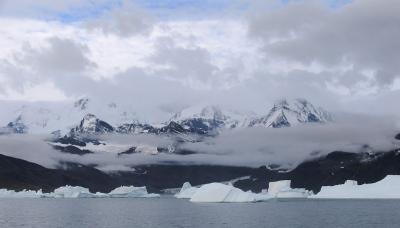 |
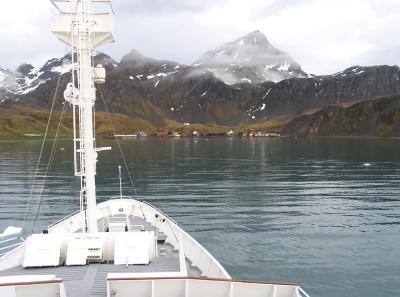
Founded by Captain Carl Anton Larsen in 1904, - |
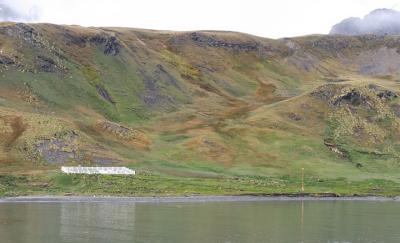
The whaler's cemetery at Grytviken is the final resting place of Ernest Shackleton. |
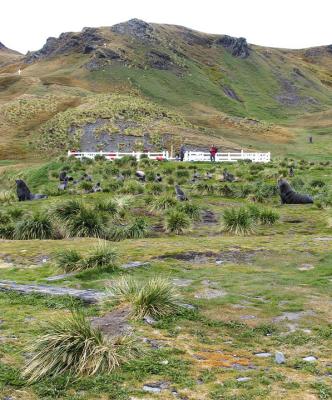
Visitors to the cemetery are challenged by fur seals, who are . . . |
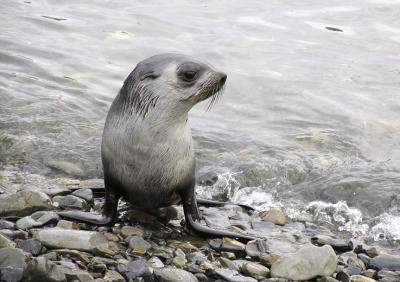
. . . protecting their infant pups. |
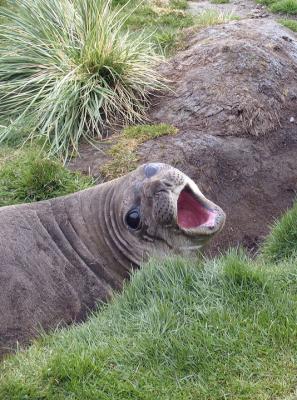
Elephant seals, including this juvenile female, also stand gaurd. |
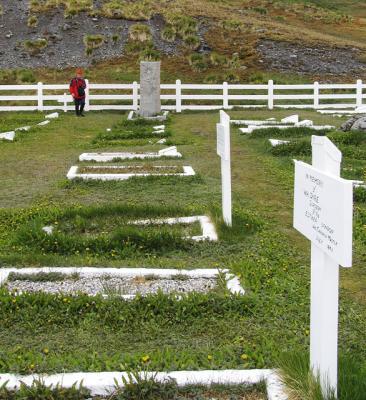
Sir Ernest -- "the Boss" to those who served under him -- has the tallest stone. |
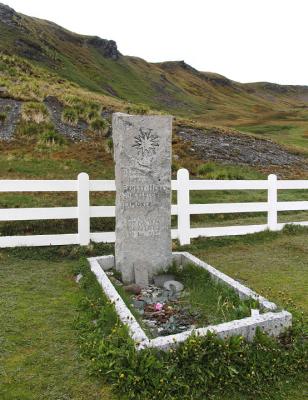
The mariner's star adorns Shackleton's headstone. |
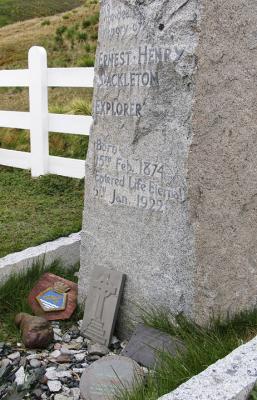
Visitors travel a long way to leave tokens of respect. |
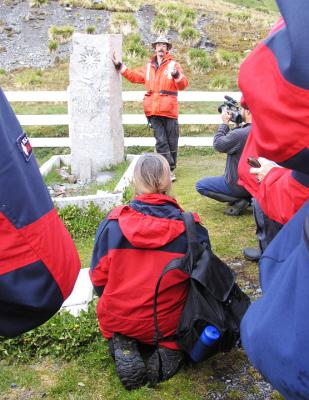
Kim proposed a toast to the Boss; we saluted with Irish whiskey. |
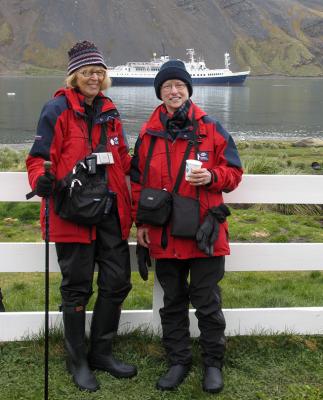
Dee and Jean, dressed for adventure in the spirit of Shackleton. |
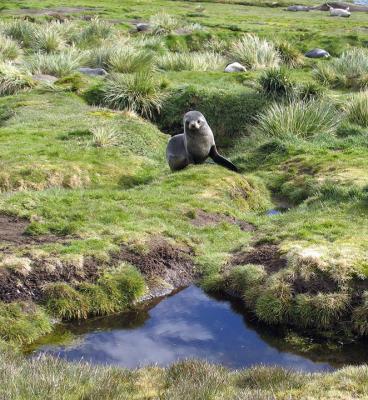
The Grytviken site is watered by glaciers. |
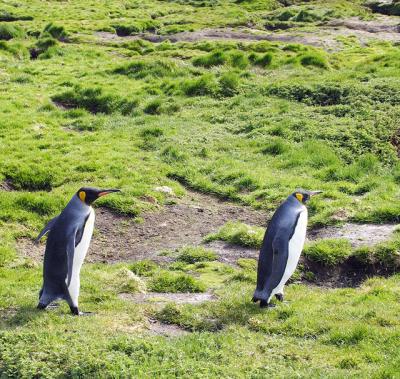
King penguins moving at a good clip . . . (for penguins on dry land). |
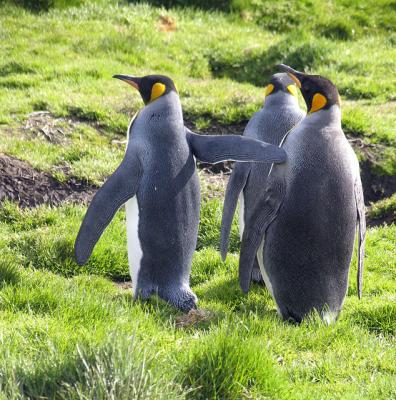
"This time, let me do the talking." |
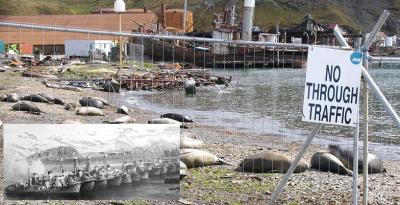
This steam-driven whaling vessel, on the beach for 50+ years, has its (rusted solid) harpoon gun poised for action. |
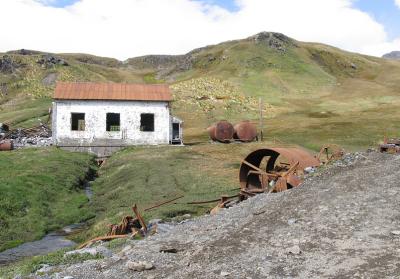
The former hydro power house, Grytviken whaling station. |
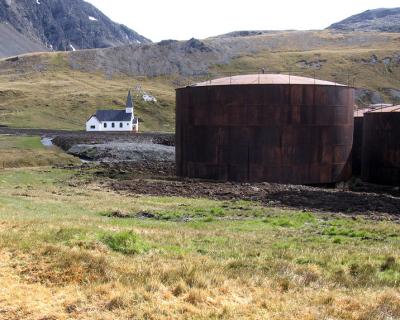
Adandoned fuel oil tanks and the restored church. |
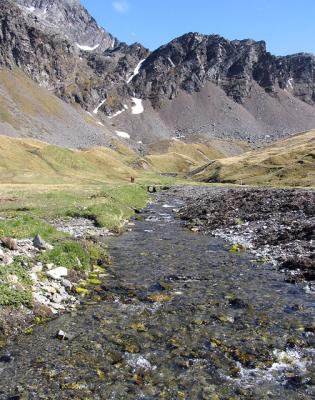 |
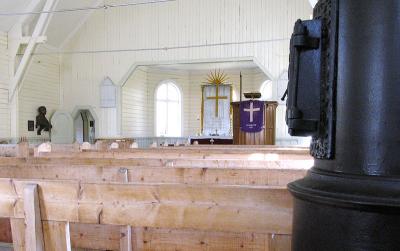
In the whalers' church, it's easy to imagine the "Shipmates, . . ." sermon from MOBY DICK being delivered from the pulpit. |
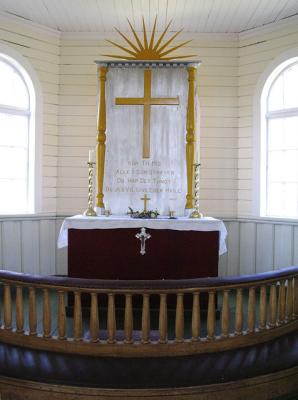 |
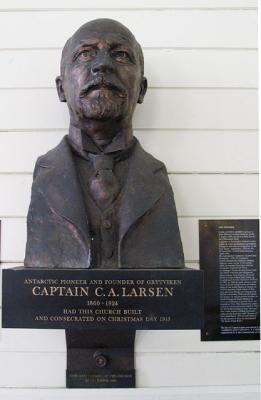
The Norwegian Larsen sailed with Otto Nordenskjold's Swedish Antarctic Expedition (1901-04), then founded Grytviken, - |
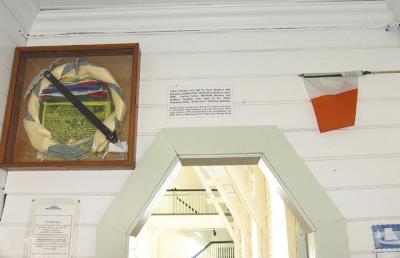
Shakleton memorials in the whalers' church. |
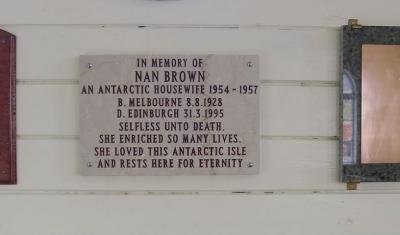
Mrs. Brown's book ANTARCTIC HOUSEWIFE (1971) describes life in Grytviken in its last years as a whaling station. |
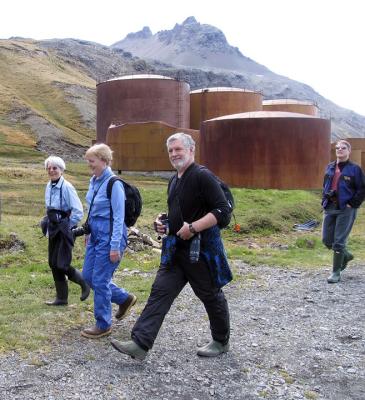
Some of the group chose a hike in the hills above Grytviken. |
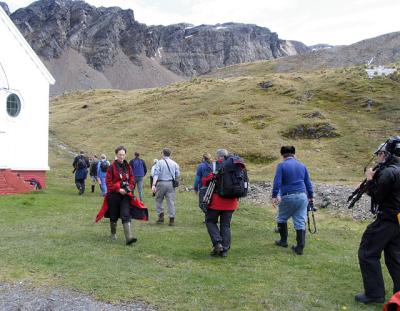 |
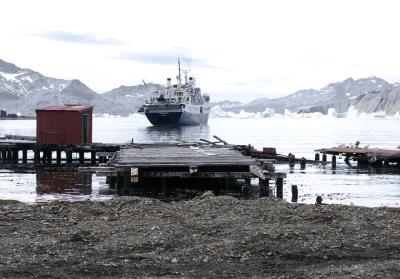
Endeavour awaits our return. |
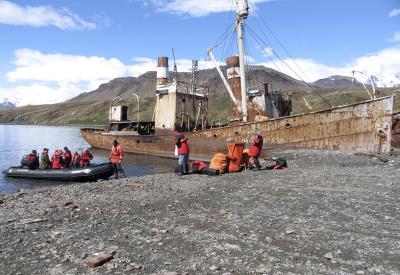 |
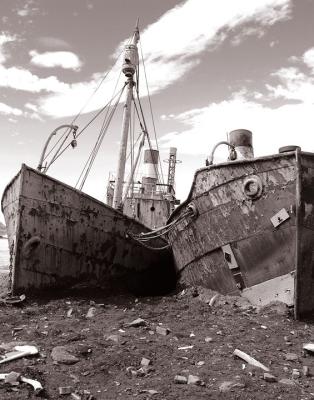
Abandoned steam sealers rafted up in King Edward Cove. |
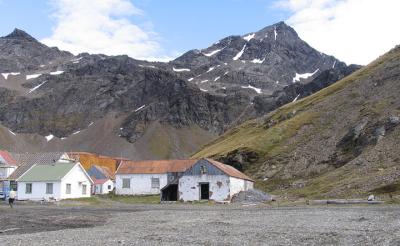
The old Grytviken whaling station is undergoing restoration. |
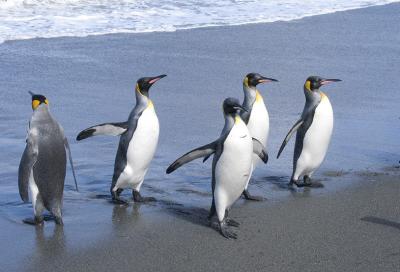
"What do you mean, 'It's too cold.' We're penguins!" |
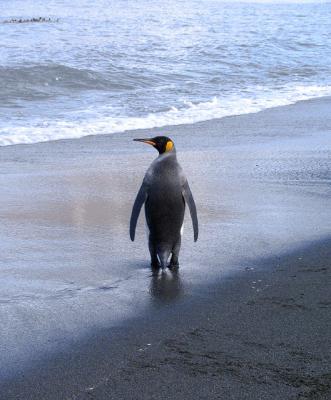
"--Sigh-- " |
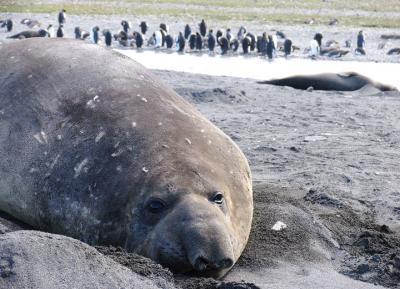
Elephant seals are named for the males' prominent noses; this one is a juvenile. |
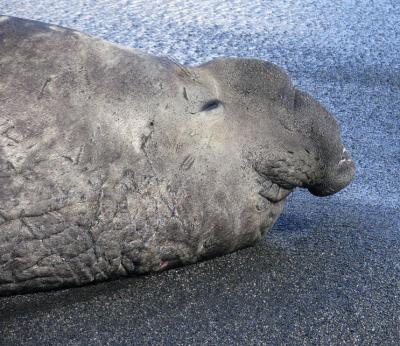
Older male elephant seals all have battle scars on their necks. |
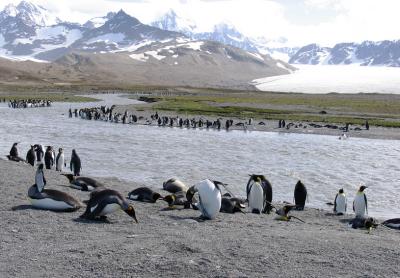
Beach calesthenics. |
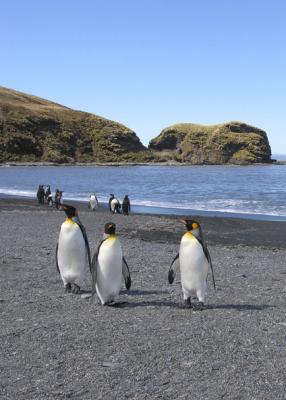
"It's fascinating that they walk erect, but I've never seen one swim?" |
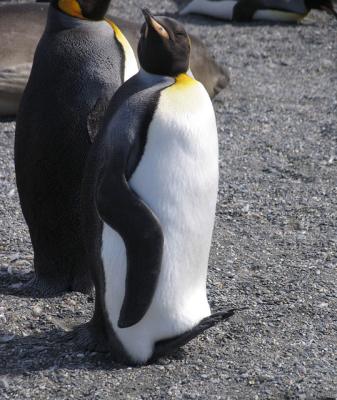
"It's a penguin thing . . . ." |
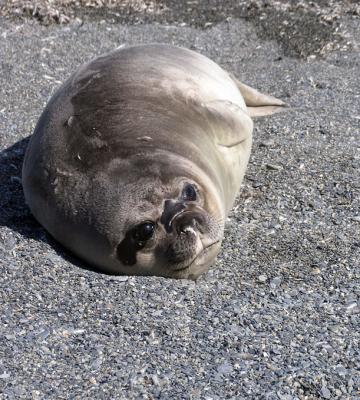
In their four weeks of nursing, elephant seal pups gain 20 pounds a day. |

King penguins gravitate to lenses. |

Barren muddy flats near glaciers are the kings' preferred habitat. |

"I hate Lindblad . . ." (Apologies to Quantas.) |
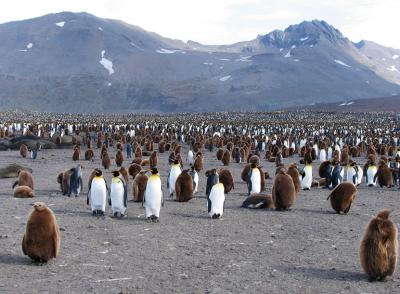
British sailors dubbed young kings "oakum boys" because their down coats resemble oakum, - |

Teenage angst . . . |

In ornithlogical texts, this is known as the "ecstatic display." |
![Christina's [The Penguin's] World](https://a4.pbase.com/u40/jeanmcc/medium/39289754.6779.jpg)
"Christina's [The Penguin's] World" |

"Don't ask." |

A recently hatched chick is always hungry. Anything might be food, even Jean's boot. |

"Are you my mother?" |

The ship's naturalists estimated 200,000 king penguins at this site. |
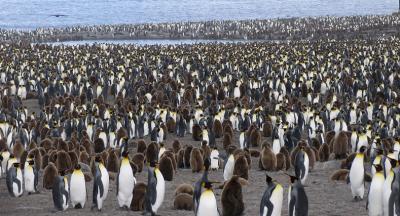
When skuas (upper left) begin to circle at tea time, a mournful penguin cry of alarm sweeps across the valley. |
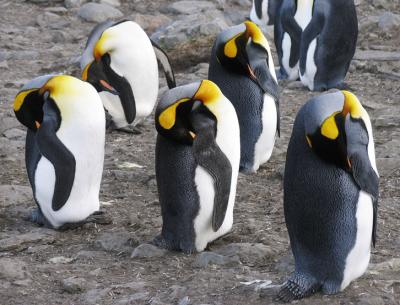
Safety in numbers: napping penguins group together in orderly rows. |
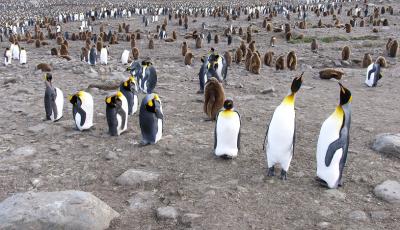 |
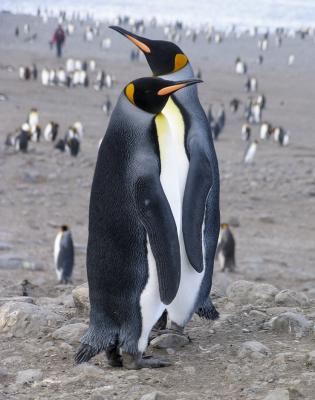
The resolution and out-of-focus "bokeh" of the Pro 1's lens make it a true "L." (Find a Canon photographer for translation.) |
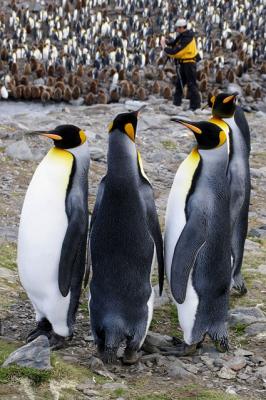
"Who's your photographer?" |
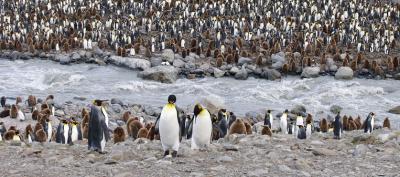
A king and his court. |
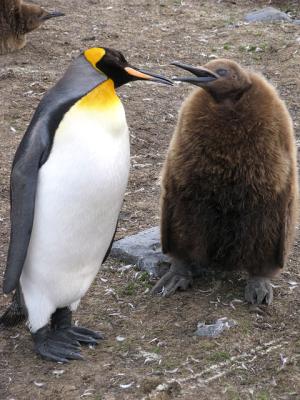
Chicks rely on half-digested krill from their parents, both of whom bring food. |
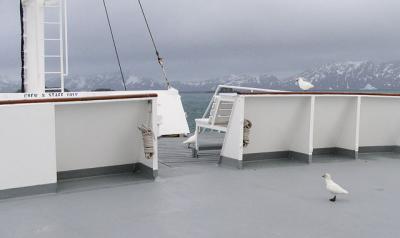
Inquistive snow petrels pay us a visit on board the ship. |
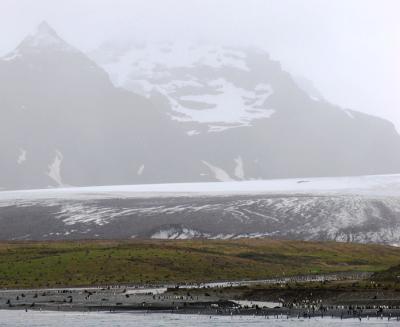
Approaching another enormous king penguin rookery. |
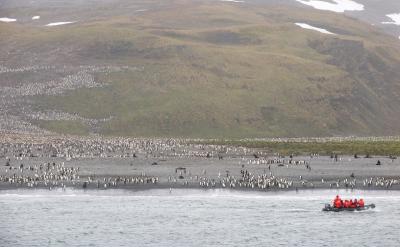 |
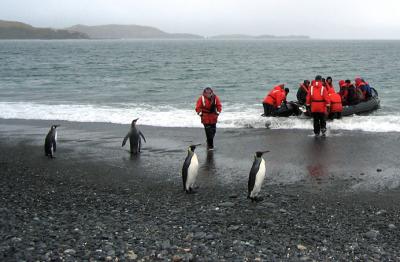 |
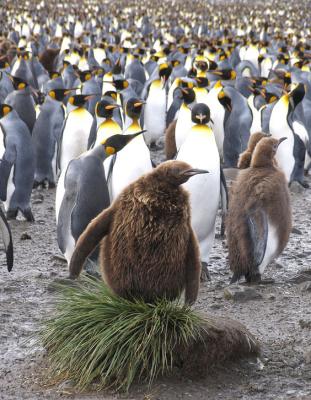 |
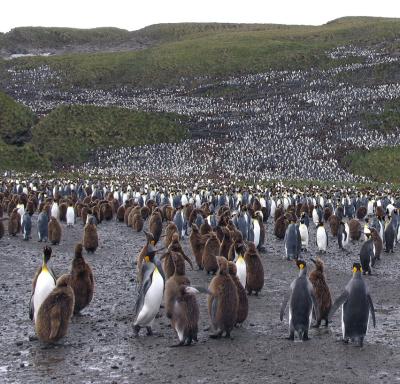
Salisbury Plain is the path of a glacier that has now receeded. |
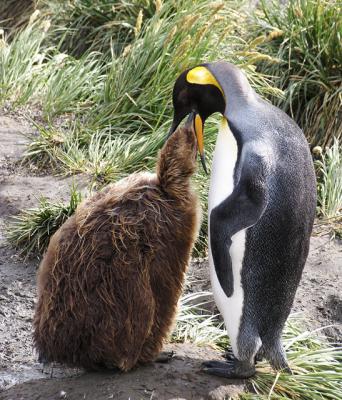
Chick feeding on regurgitated krill. |
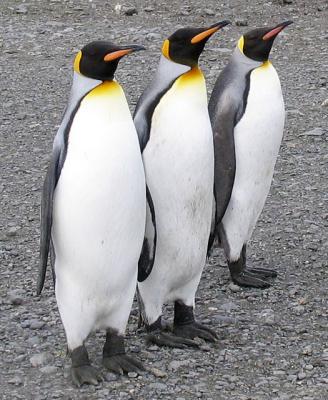
"King, party of three, please." |
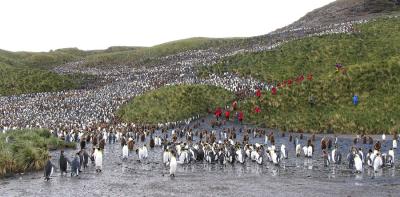
"Right flank, advance . . . close the gap and we'll have them surrounded!" |
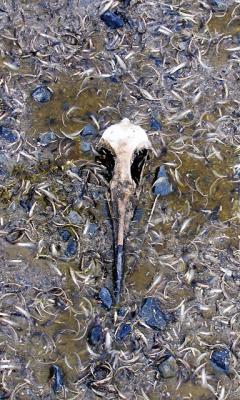
A skull and breast feathers are all that remain of this unfortunate king. |
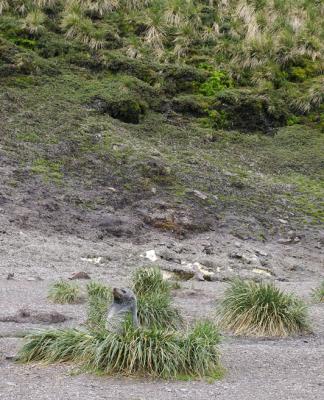
On the plateau above the beach, fur seals find comfort in the tussock grass. |
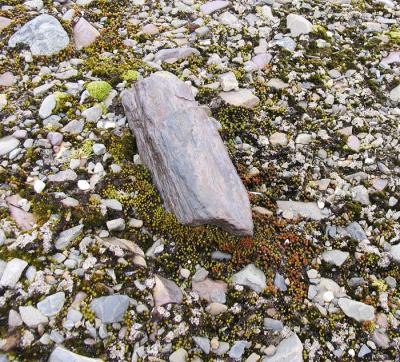
Life begins where a glacier has receded. |
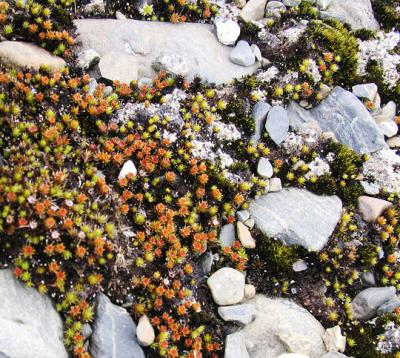
Sedum (a.k.a. Stonecrop) |
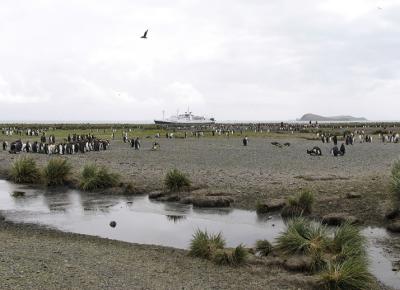 |
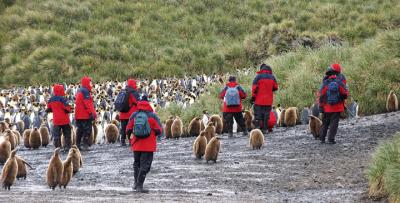
Ever-hopeful oakum boys looking for food. |
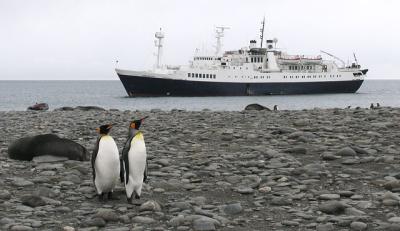
A pleasant sight from shore at any range. |
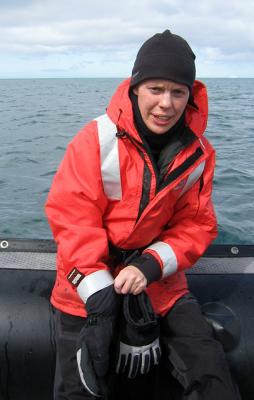
Assistant expedition leader Lisa Lagerstrom. |
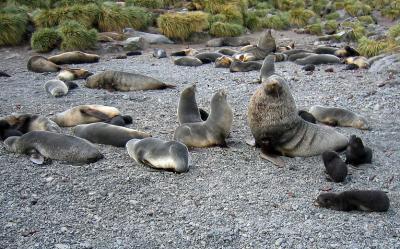
Fur seals and pups resent any intruders, so we moved around them quickly and carefully. |
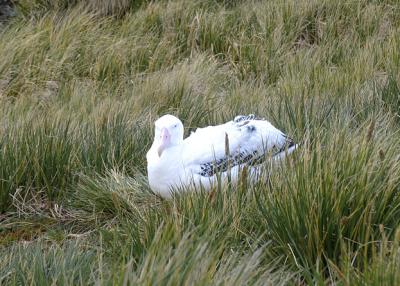
A female wandering albatross on her nest. |
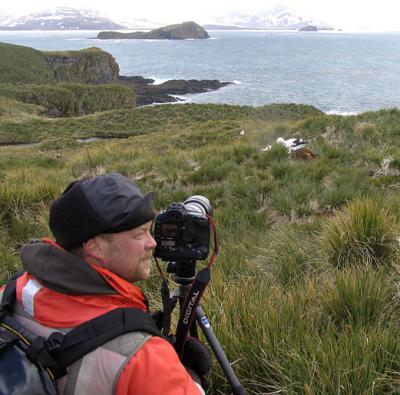
Expedition leader Ralph Lee Hopkins setting up for a shot. |
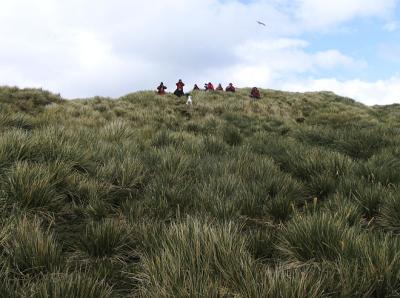
Photographers watch a fledgling albatross while its parent watches them. |
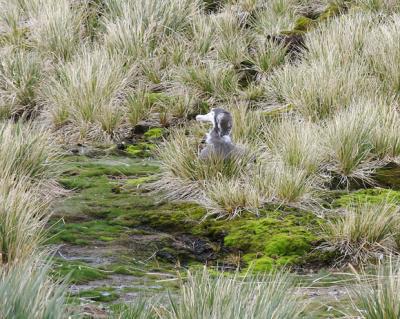
A first-year wandering albatross, about to test its wings. |
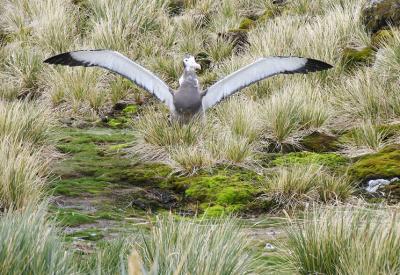 |
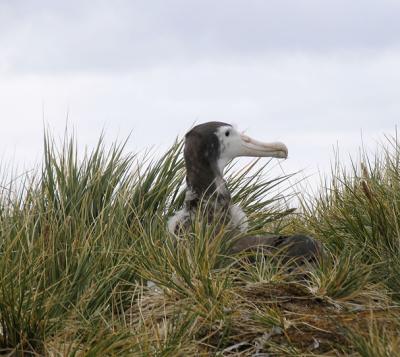 |
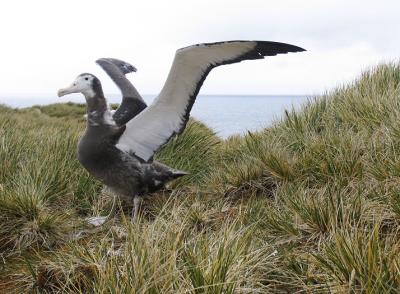 |
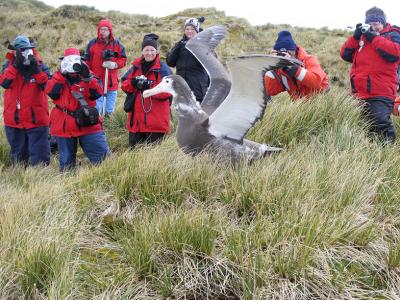 |
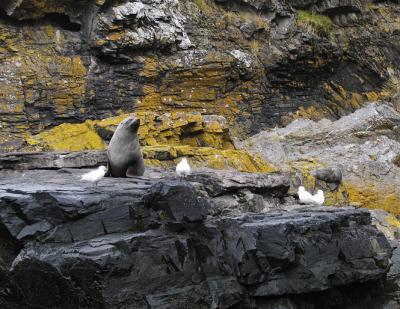
Fur seal attended by snowy sheathbills. |
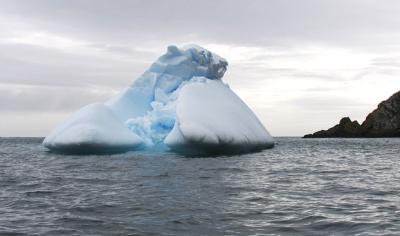
Who says there are no polar bears in the Antarctic? |
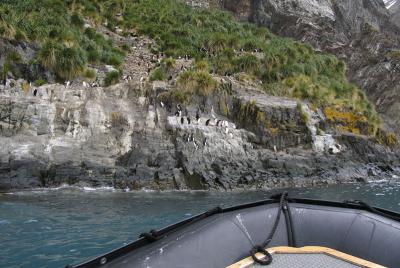
The sheer walls of Hercules Bay are too slippery for us . . . |

. . . but no problem for these macaroni penguins. |
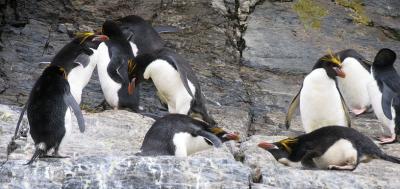
To early whalers, the yellow tufts resembled the "macaroni" feathers worn on the hats of 18th-century London dandies. |

"Mr. De Mille . . . ?" |
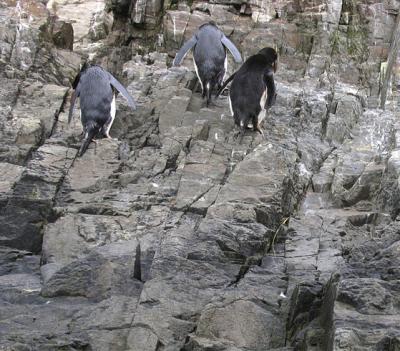
These penguins jump up rock faces in the same way as their smaller cousins, the rockhoppers. |

Across the bay, a female fur seal surveys the morning scene. |
 |

Macaronis are about 27 inches tall. |
 |

"It's my rock! You got a problem with that?" |

"Keep going!" |
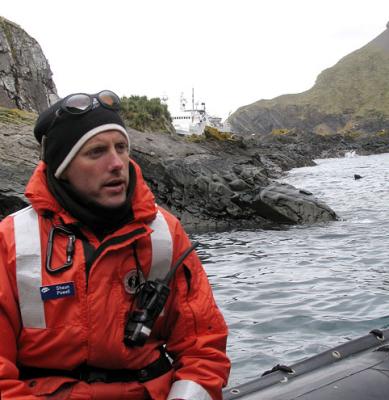
. . . Lecturer Shaun Powell seems taken aback. |

Endeavour holding station in the mouth of Hercules Bay, with Zodiacs close to port. |
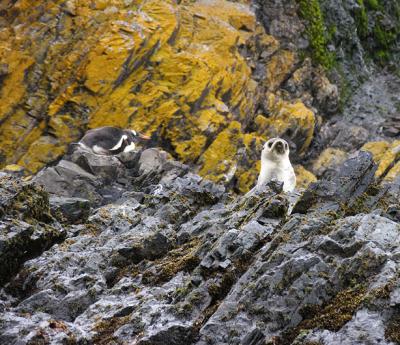
This gentoo penguin and young fur seal share a room with a view. |
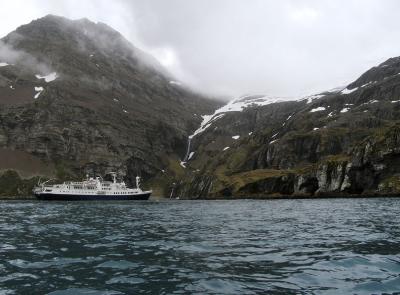
The 110-passenger Endeavour looks very small against the cliffs of Hercules Bay. |
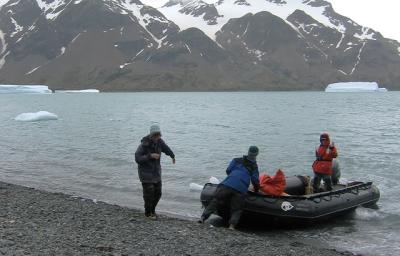
Landing at Fortuna Bay for the "Shackleton Walk." |
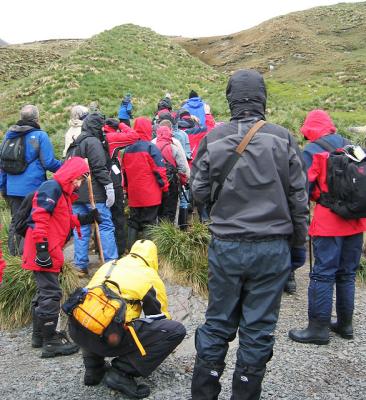
Hikers gather to trek the final four-mile segment of Shackleton's heroic crossing. |
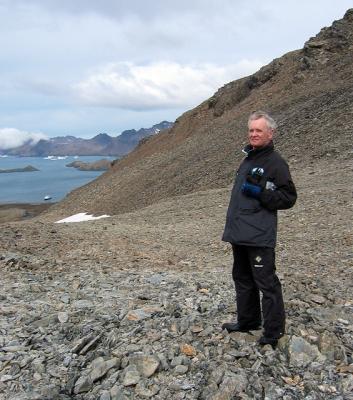
The ship's doctor at the halfway point, with Endeavor far below at Stromness. |
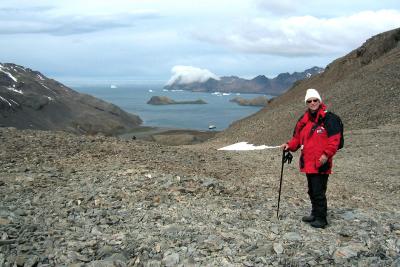
How you gonna keep her back on Broadway, now that she's seen Stromness? |
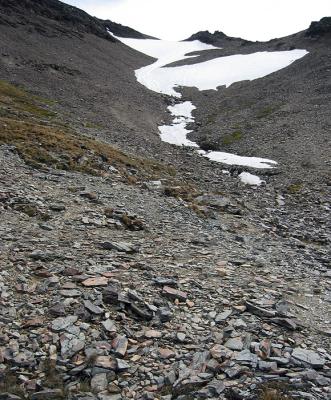
Like Shackleton, we slid down part way. |
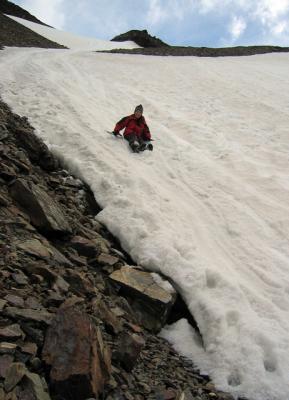 |
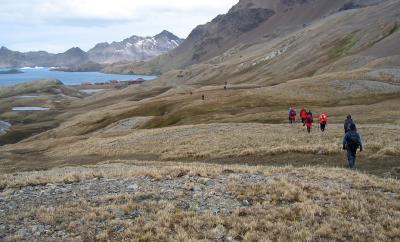 |
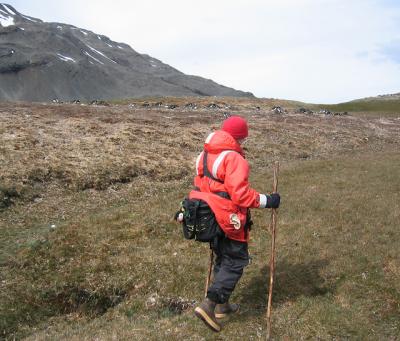
The gentoo penguins of South Georgia nest in meadows or tussock grass, well above beach level. |
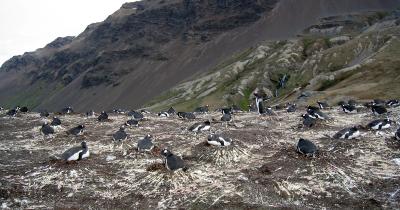
Gentoos return to the same area -- and generally the same mate -- to breed each year. |
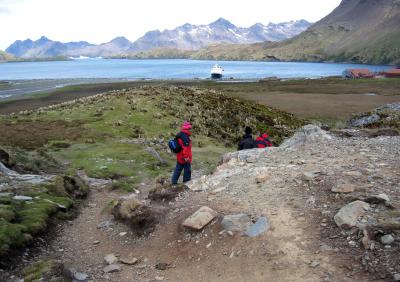 |
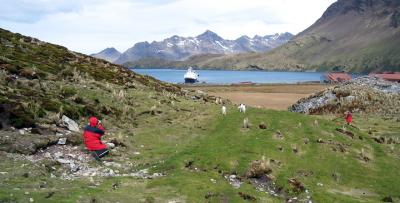
Those who travelled by ship to Stromness had time to walk up into the hills to meet the trekkersand take photos. |
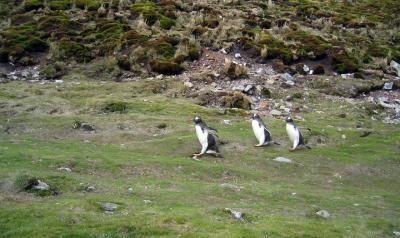
The "commuter walk" from the bay to the nest. |
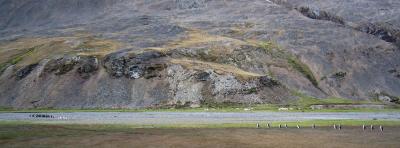
Sharing the beach with king penguins are Norwegian reindeer, introduced in 1911. |
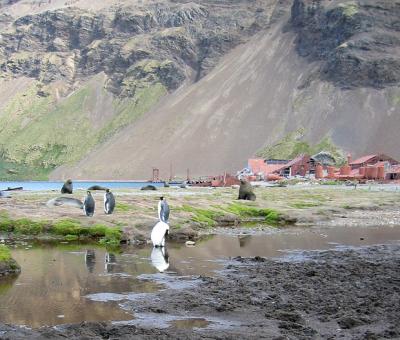
The manager's home at the Stromness whaling station marked the end of Shackleton's heroic journey in May 1916. |
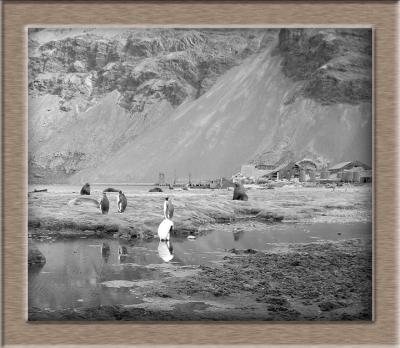
In the spirit of Frank Hurley: a quadtone image of what was once called "the slum of the Southern Ocean." |
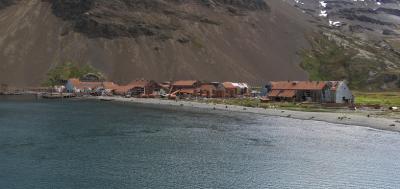
The whaling station was a floating factory site (1907-12), shore station (1912-31), then major repair yard (1931-61). |
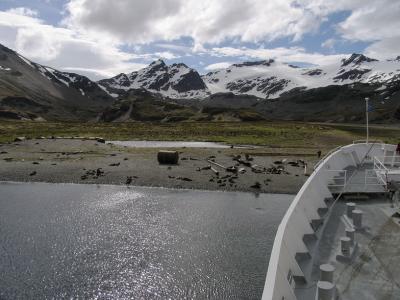
In 1961, when the station was abandoned, fur seals were considered extinct in this area. |
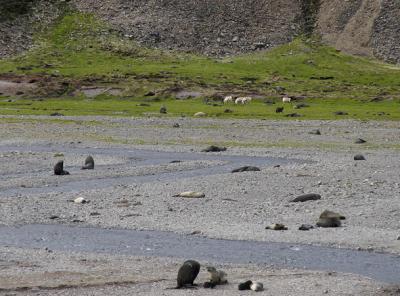
Fur seals and reindeer. |
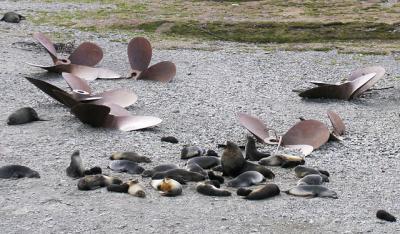
A beachmaster and his harem. |
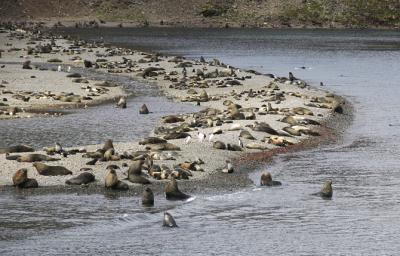
As in Miami, real estate on the ocean side of the sound is more valuable. |
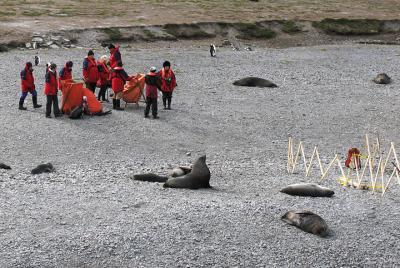
Fencing to protect the red-clad guests from the gray-clad hosts, and vice-versa. |
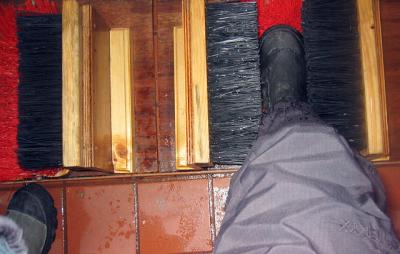
Boots are carefully cleaned to prevent contamination between landing sites. |
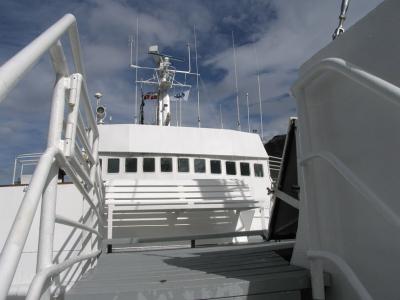
Endeavour's bridge. |
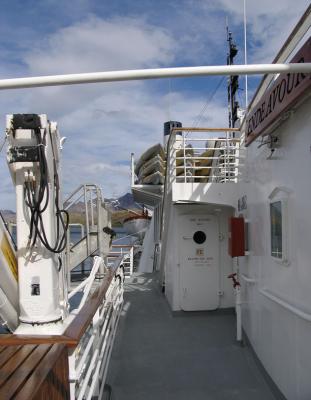
So that's where they keep the kayaks. |
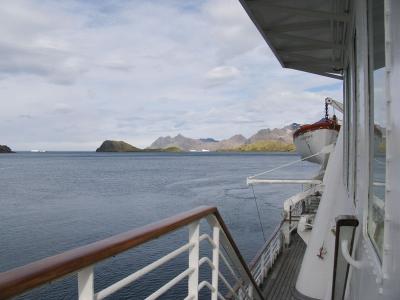
A lifeboat, considerably larger than the "James Caird" in which Shackleton and his companions crossed the South Atlantic. |
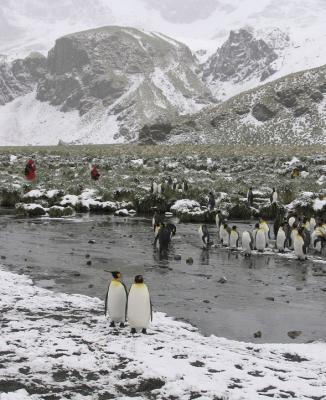 |
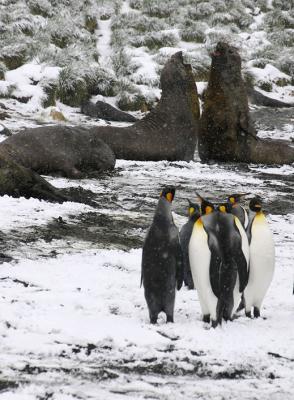
Bull elephant seals battle before an audience of king penguins |
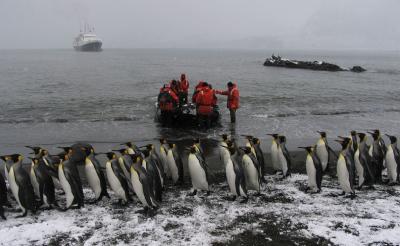
Fight fans stream forward to see the action. |
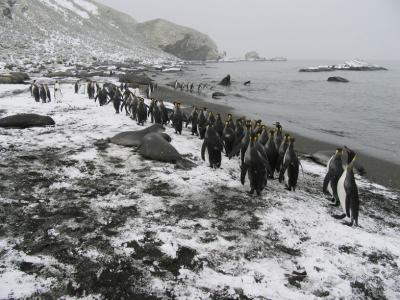 |
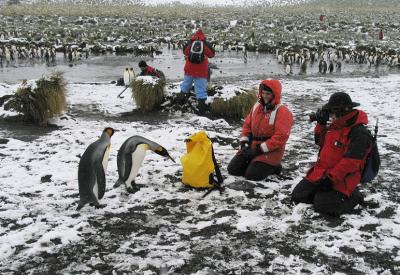
"Oooh, I like this! How much?" |
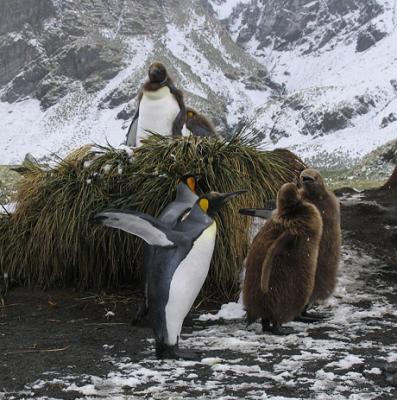 |
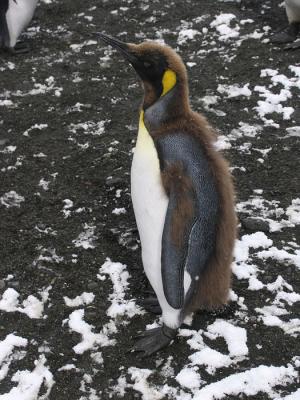
Oakum boy with mohawk. |
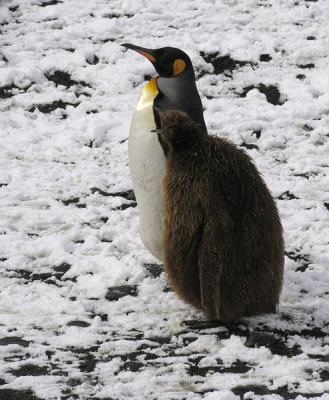
"Please, Mom, I want some more." |
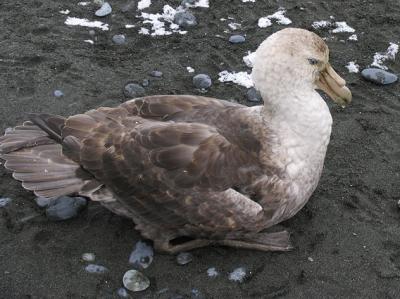
The southern giant petrel often lives near penguin colonies and lives on penguin carrion. |
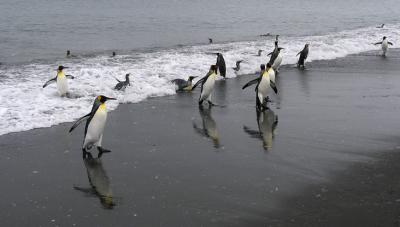
Kings explode out of the surf. |

Just over three feet tall, the king penguin is truly a regal bird. |
 |
 |
 |

When on top of the water, penguins look like an exotic form of duck. |
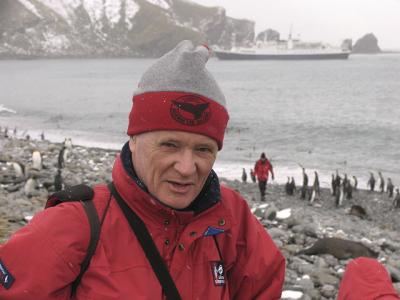
Dr. Peter Littlewood, the ship's physician. |

"Gentoo Heights," a nesting area overlooking the beach. |

A gentoo showing off her newly hatched chicks. |

Penguins in the 'hood. |

"Carbon fiber! It's more expensive, but you can taste the difference." |
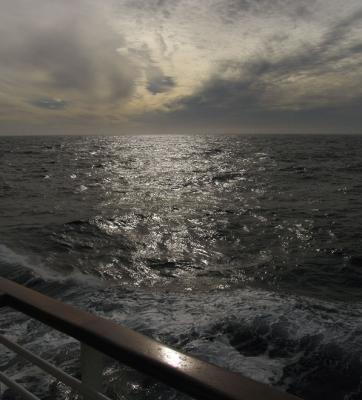
After dinner, two hours before sunset. |
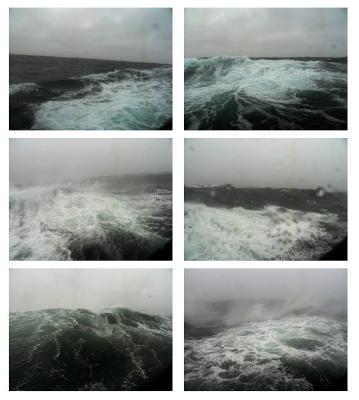
Porthole photos of a Southern Ocean gale, shot from our cabin. |
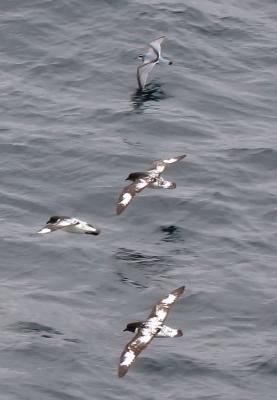
Pintado petrels and a lone antarctic prion. |
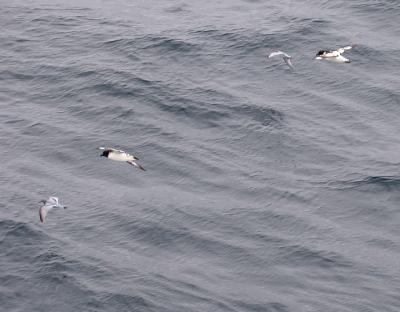
In the contest for food stirred up by the ship's passage, the larger petrels shoulder the prions away from the inside track. |
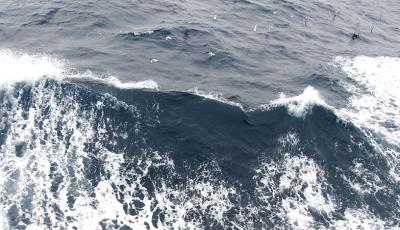 |
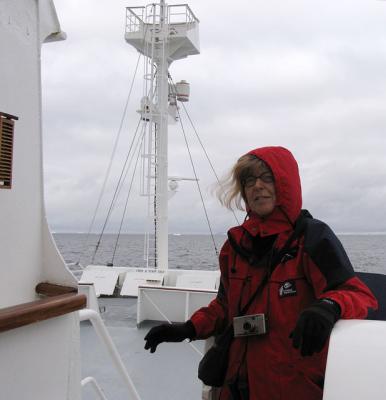
For several days after the storm, it was breezy on deck. |
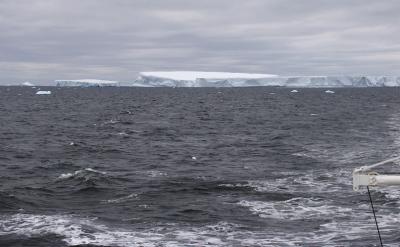
Tabular ice in the Weddell Sea, formerly part of the Larsen Ice Shelf. |
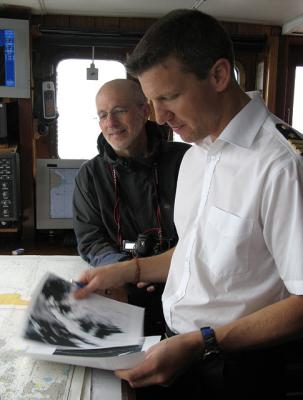
Second officer looking over ice photos. |
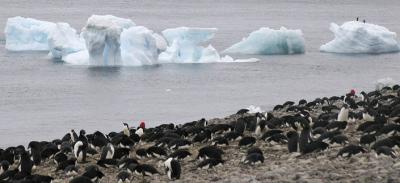
Adelie colony on Paulet Island. |
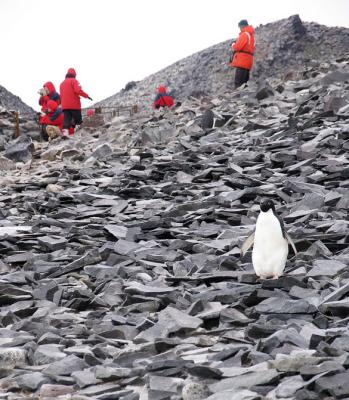
Captain Carl Anton Larsen and his crew survived the winter of 1903-04 here, thanks to 1100 ancestors of this adelie penguin. |
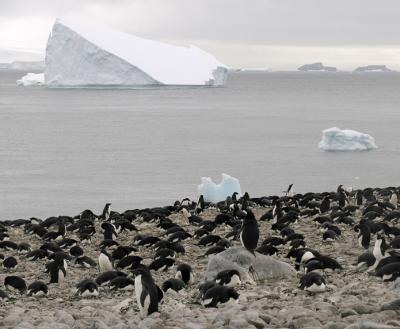
A tipped-over tabular berg. |
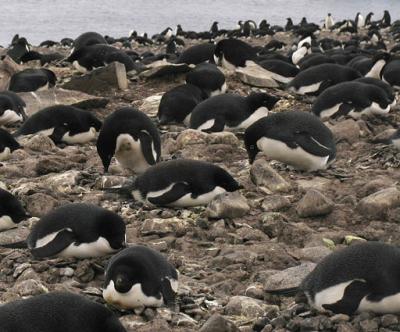
Unlike gentoos, adelies nest on the beach. There are some 60,000 pairs of adelies on Paulet. |
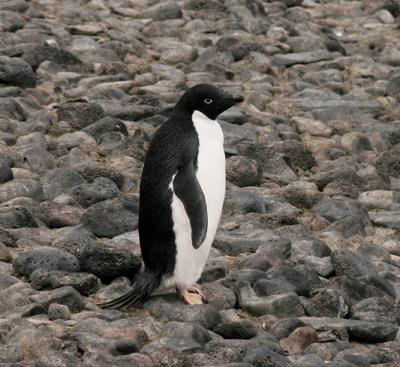
In 1837, the French explorer Dumont d'Urville named this penguin for his wife, Adele. |
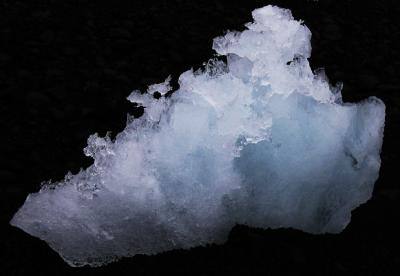
The blue color of this “bergy bit” shows that it is “old ice,” with most of the salt leached out. |
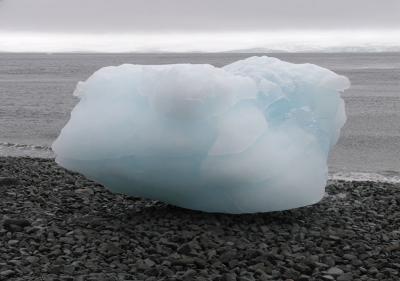
Beached blue ice "growler." |
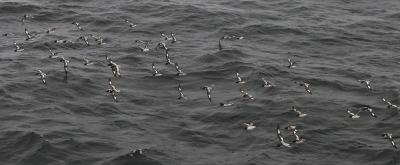
They're back. |
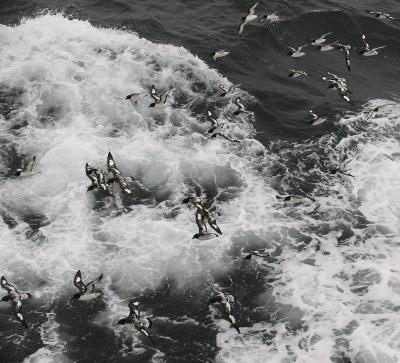
Pintado petrels wheel and turn in the ship's spray. |
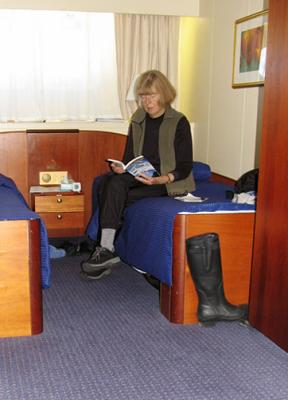
Dee poses in our cabin with Todd's "Birds & Mammals of the Antarctic, Subantarctic & Falkland Islands," our basic reference. |
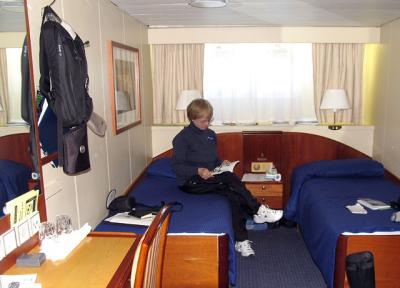
Jean's turn to pose. The drawers had special locks to keep them from opening when the ship rolled. |
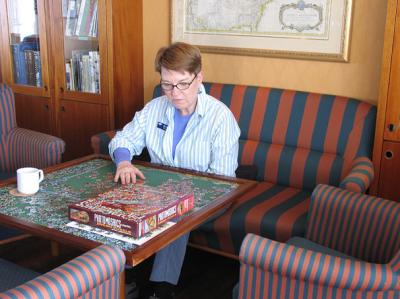
In the ship's well-stocked library, one passenger chose a jigsaw puzzle, . . . |
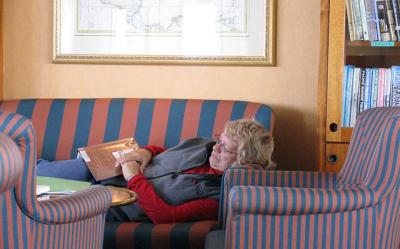
. . . while another settled for a nap. |
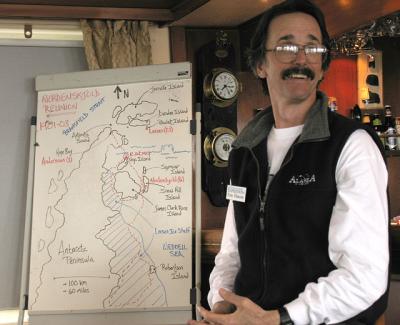
Kim tells the story of the Nordenskjold reunion at Snow Hill Island, our next destination. |
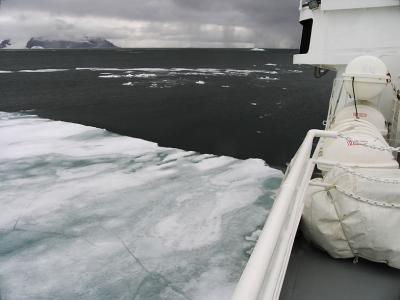
Leaving snow squalls astern, Endeavour heads into the pack ice. |
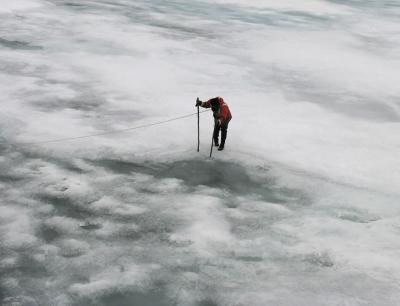
Testing the ice . . . a "hands-on" approach. Ice too weak for landing, we turn back north and head for Deception Island. |
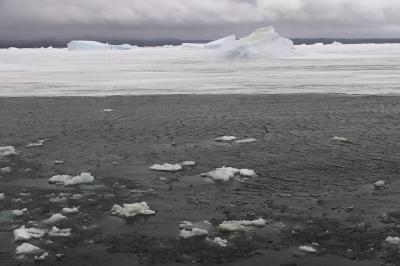
Bergs in the pack ice as we say good-by to the Weddell Sea. |
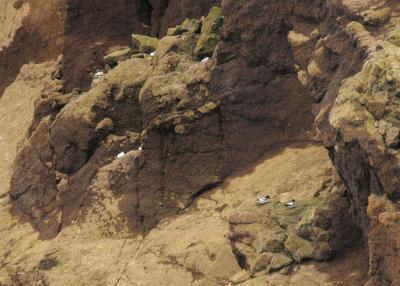
Pintado petrels nesting on the cliffs of Whaler's Bay, at a spot called Neptune's Window. |

Lecturer Karen Copeland displays samples of pintado nesting materials. |

Snowmelt on crater walls is due to geothermal heat, not air temperatures. |

Entombed whale boat is now a nesting site for petrels. |

Once upon a time, on a day much like today ... |

in fact very much like today, ... |
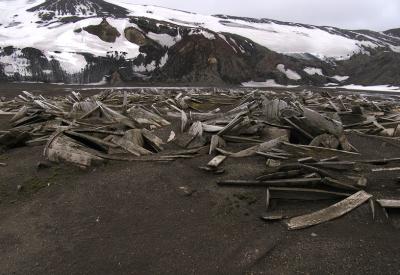
in a place as cold and desolate as this, ... |

a seemingly sophisticated New Yorker of Midwestern origins, took off her nice warm parka and most of her other clothing, ... |

posed for a cheescake shot in sub-freezing temps, .... |

and then attempted to walk on water. |

She failed. |
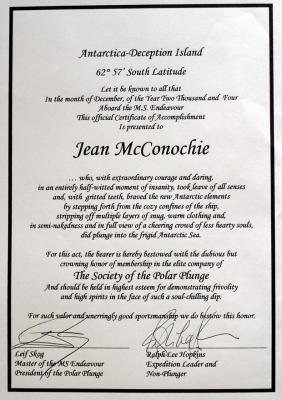
But, they did give her this auspicious document to display in her otherwise tasteful home. |

Barrel staves on the floor of the caldera. |
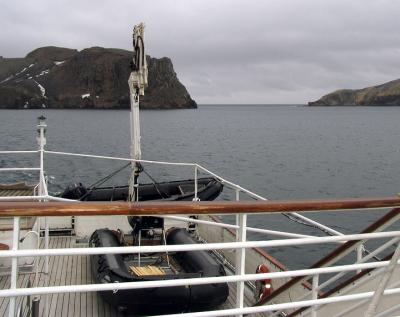
Neptune's Bellows, the entrance and exit of Whaler's Bay. |
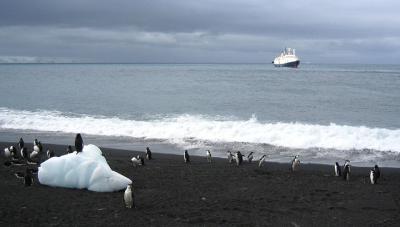
A big bergy bit (or small growler) provides a chinstrap lookout point onto the Bransfield Strait. |
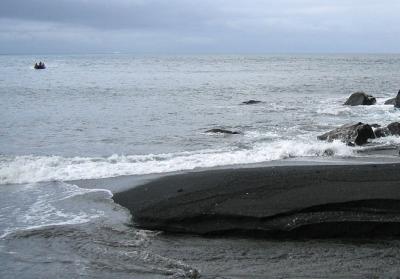
Deception Island's black volcanic sand is more luxurious than the rock beaches that we've been on up to now. |
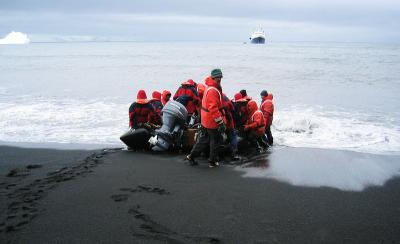
Angle of beach makes landing in light surf trickier than it looks. |
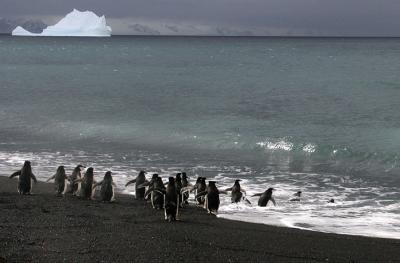
Chinstraps enter the water one at a time. Smart ones on the beach watch for leopard seals. |
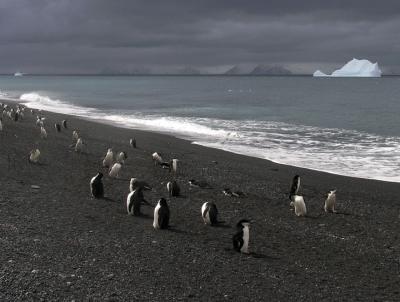
Chinstraps taking in a low-angle sun. |
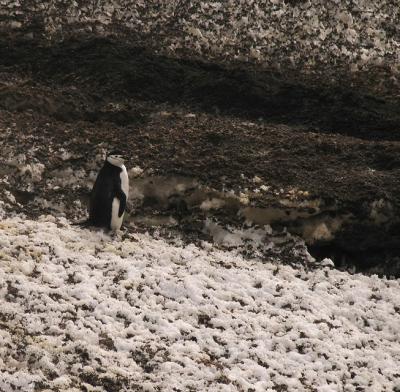 |
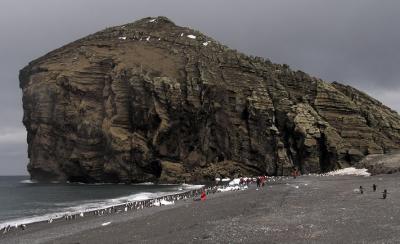
Baily Head. |

We watched this berg break apart. |

Sunrise over the Neumayer Channel (6 a.m.). |
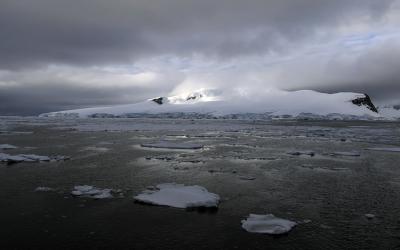
Morning light strikes the cliffs on Anvers Island; pancake ice in foreground. |
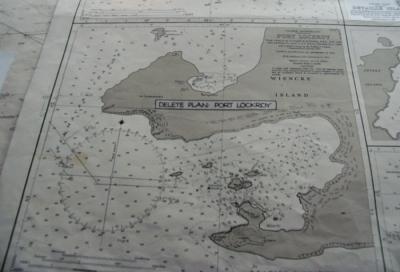
Nautical chart of Port Lockroy. |
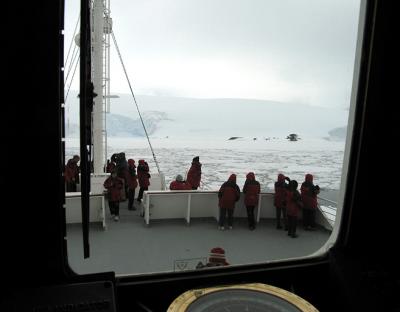 |
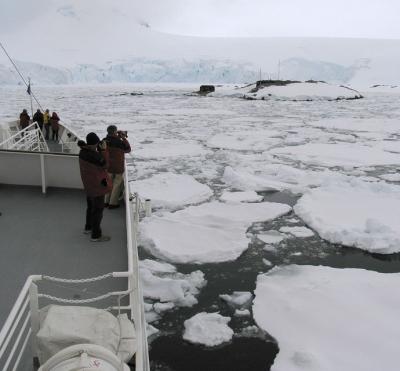
Endeavour attempts to shoulder its way through the pack to the British base. |
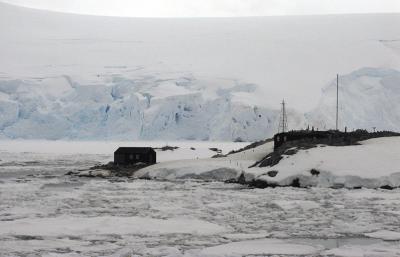 |
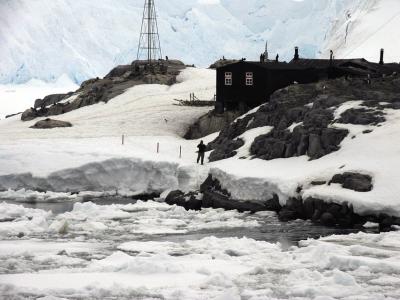
This is about as close as we'll get; the man on shore may have to be disappointed. |
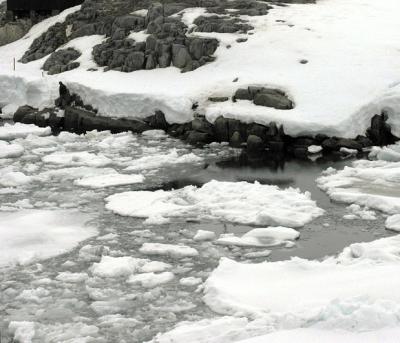
We back away. |
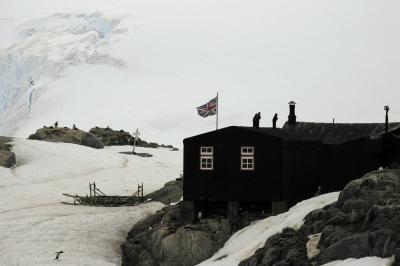
Penguins near Bransfield House seem to celebrate our defeat. |
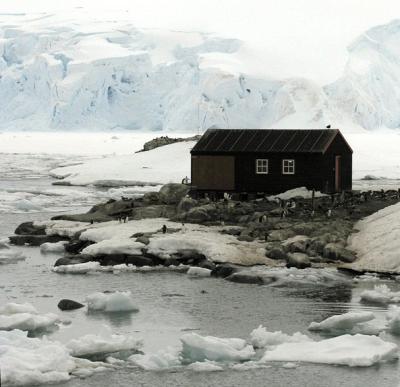 |
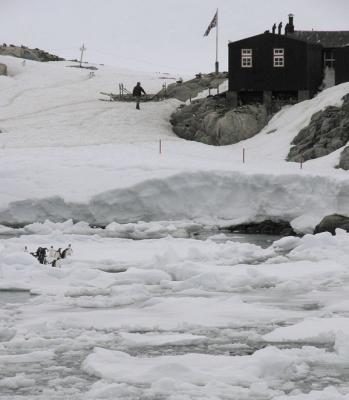 |
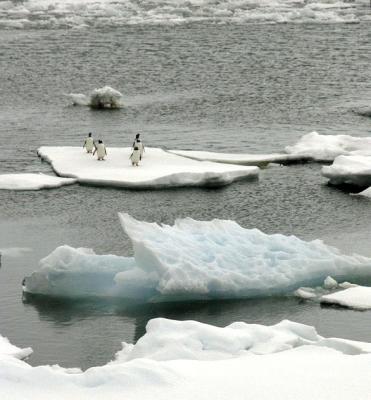
Gentoos on pancake ice watch as we maneuver. |
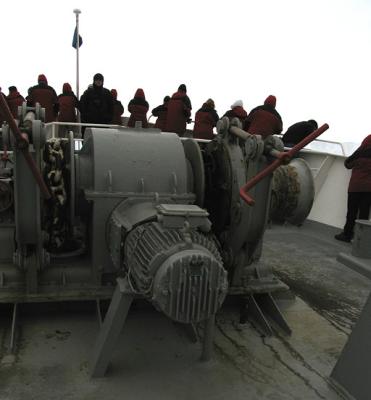
Human spectators man the bow. |
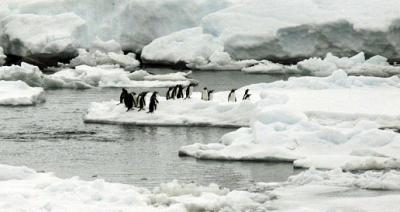 |
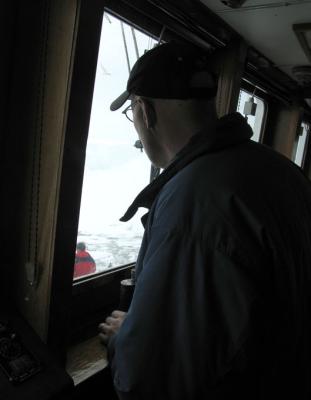
Captain Lief Skog . . . |

. . . consults the radar, . . . |

. . . and has the second officer plot an approach to Jougla Point, Port Lockroy's "back door." |

Now, up on fast ice, . . . |

. . . we prepare to disembark. |

The door opens, and . . . |

. . . a chorus line of photographers, left foot forward, gingerly steps onto the ice. |
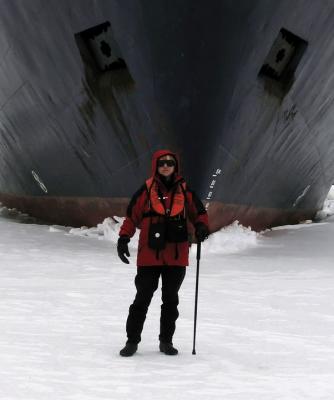
"McConochie of Antarctica" hams it up, a bit too close to the ship. |
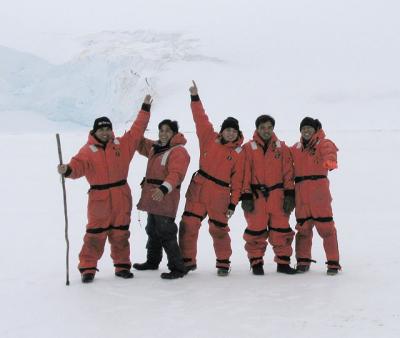
Triumphant ABs. |
 |

Over the ice and across the bay to Port Lockroy. |
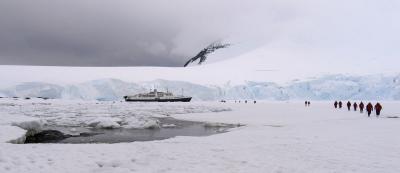
On "fast ice." |

Port Lockroy's permanent residents. |

Weddell seal vocalizing (and drooling) while sleeping. |
 |
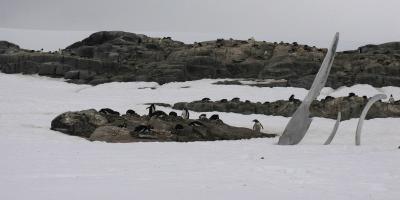
Whale bones and gentoos. |

Shags and gentoos nest side by side. |
 |
 |
 |

Heading for home (Endeavour) across the ice, . . . |

. . . Port Lockroy to our backs, . . . |

. . . we return to the ship and end our Port Lockroy adventure. |

Back in the channel, we are greeted by twin ice bergs, once the tip of a large shelf. |
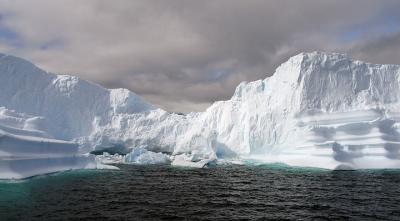 |
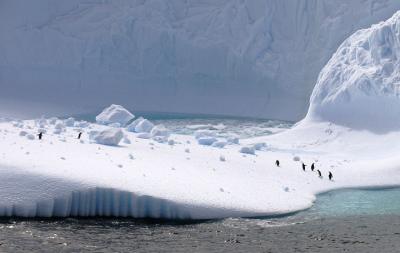
Penguins on the porch . . . |
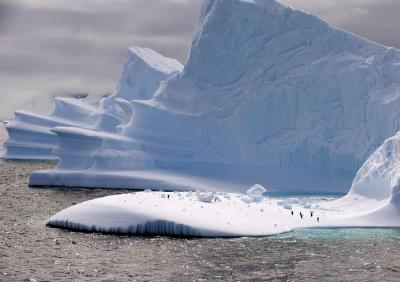
Gentoos hitch a ride, while a predator leopard seal waits in the water. |
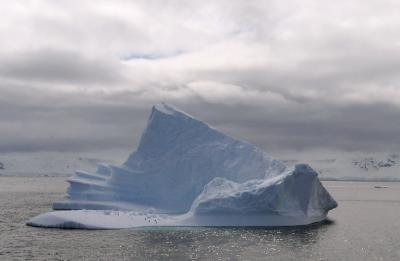
"Let him wait!" |
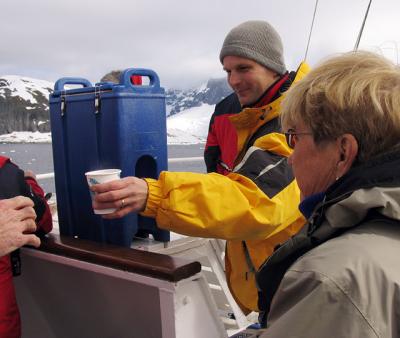
In the Neumayer Channel, we're seemingly celebrating their escape. - |
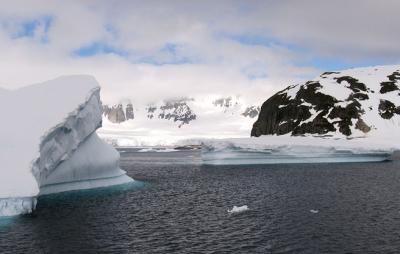
Back in our Zodiac. |
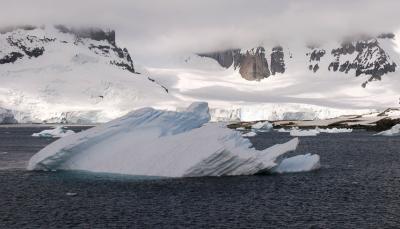 |
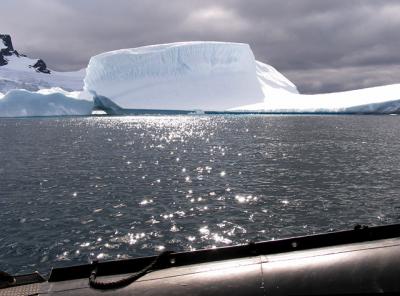 |
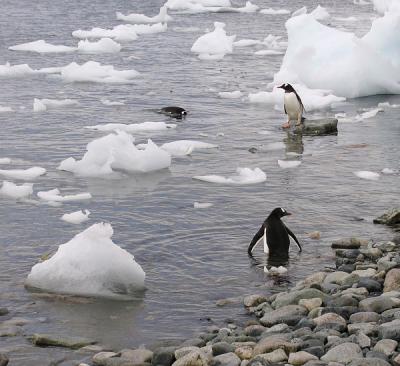
Back on the beach, . . . |
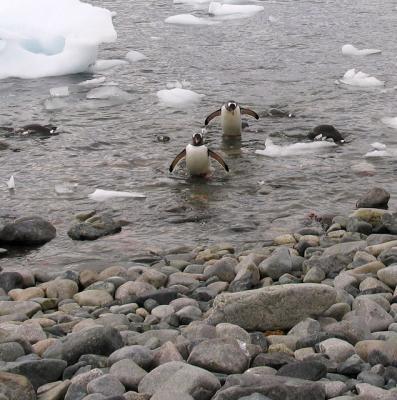
Jean sits down on the beach to watch the show as gentoos emerge from the water. |
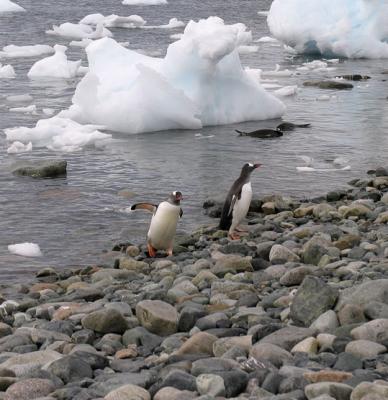 |
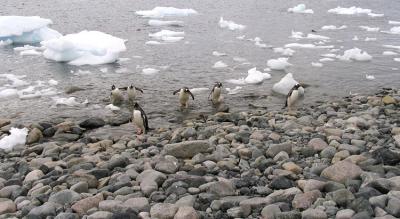 |
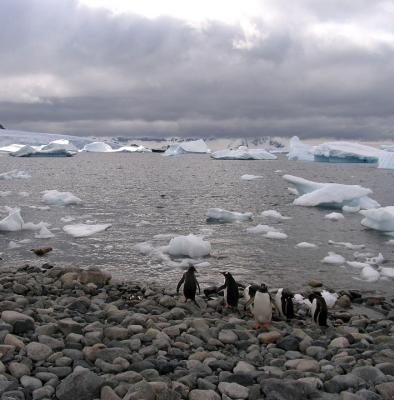
"Who's she?" |
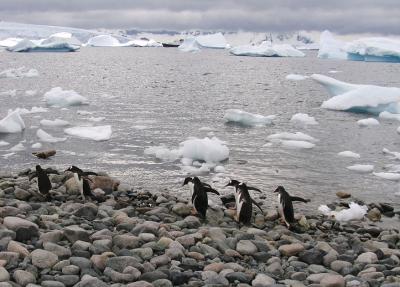
"It doesn't matter. We'll go around." |
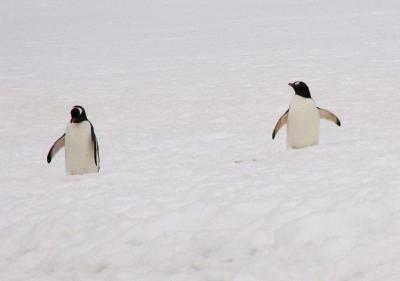
Gentoos in snow above the beach. |
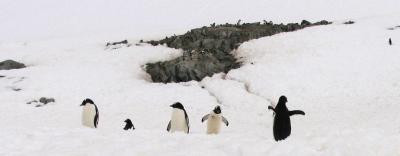
"Weren't we supposed to get a place closer to the beach this year?" |
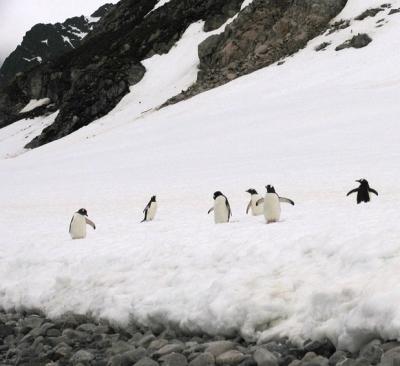 |
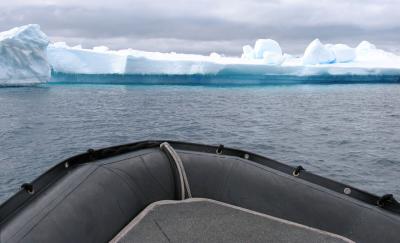
Back in our Zodiac, the magic continues. |
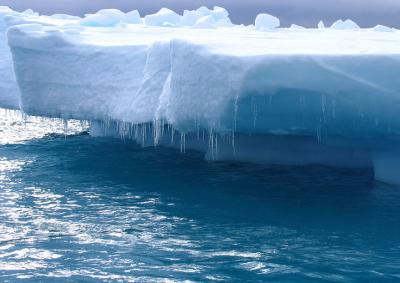 |
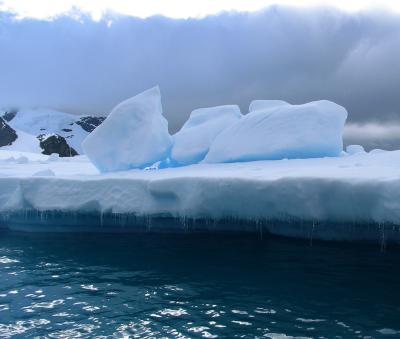 |
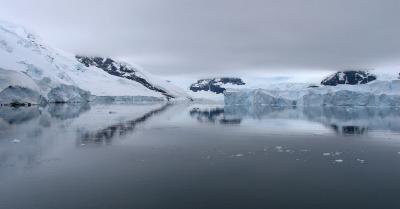
Early morning in Andvord Bay. |
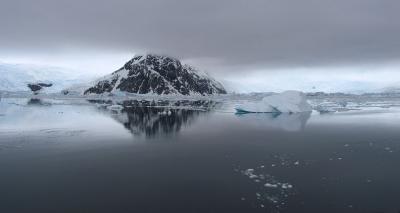 |
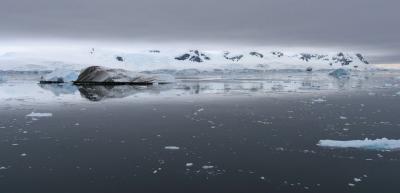 |
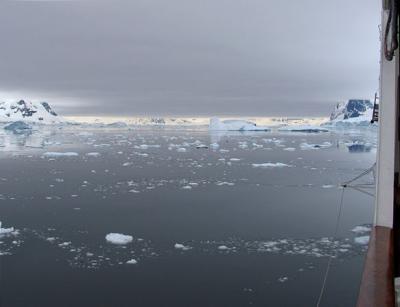 |
 |
 |
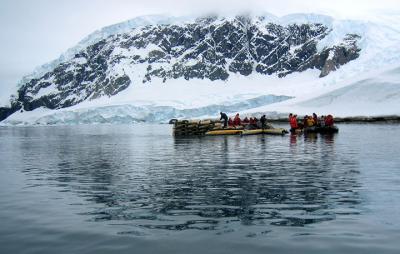
Kayaking in Neko Harbour |
 |

Ahead of us, the cliffs of continental Antactica. |
 |

North of Waterboat Point in Andvord Bay. |
 |

Rounding Waterboat Point . . . |
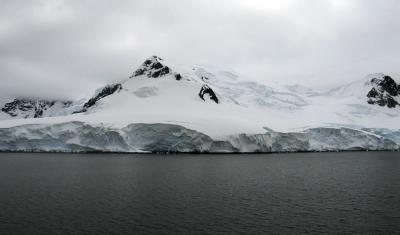
. . . into Paradise Harbour. |
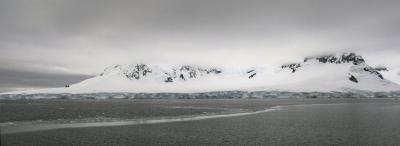
Heading south in Paradise Harbour, . . . |
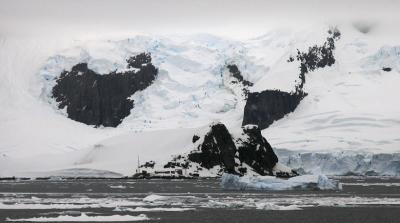
. . . we passed the glacier-dwarfed Almirante Brown Argentinian base. |
 |
 |
 |
 |
 |
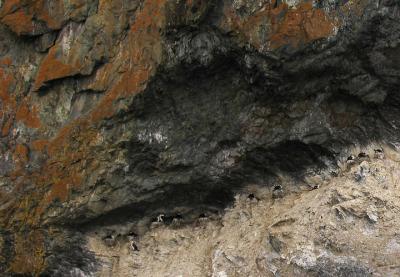
Cliffs of the Antarctic land mass shelter nesting shags in Paradise Bay. |

Endeavour noses her bow in for a close look. |
 |
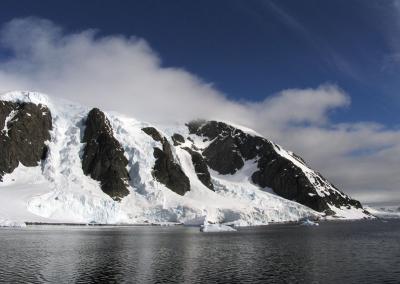
Paradise Bay below Almirante Brown, our farthest south -- 64 degrees 54.85 minutes. |
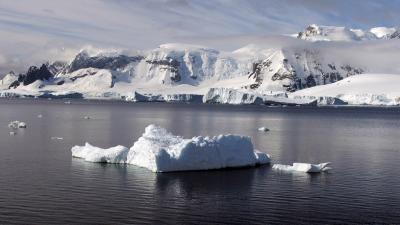
Low scud sweeps across the Antarctic peaks above Paradise Bay. |
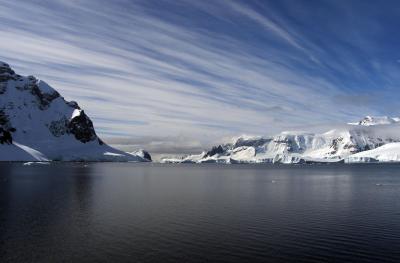 |
 |
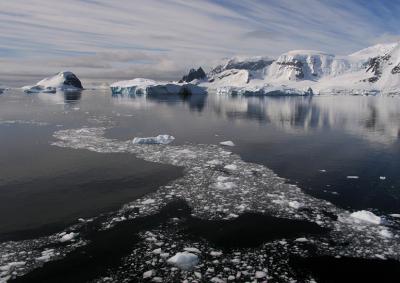
"Cruising for composition," Endeavour at dead slow generates no wake. |
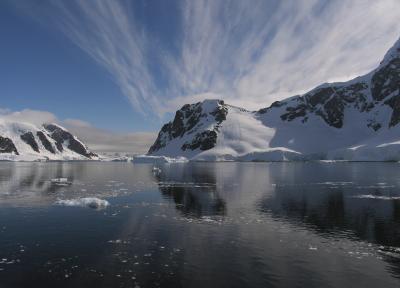 |
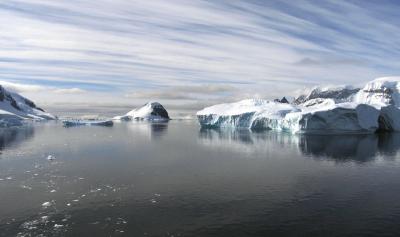
In a sunlit Paradise Harbour, there are no bad pictures. |
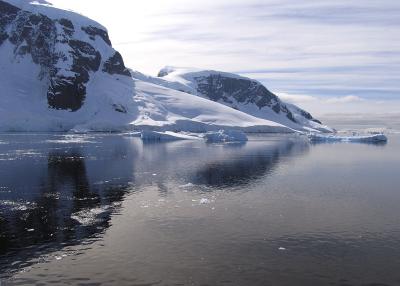 |
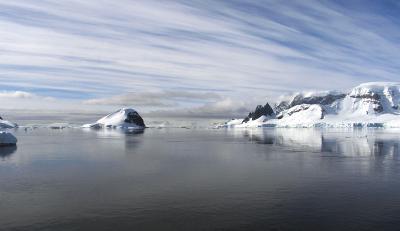 |
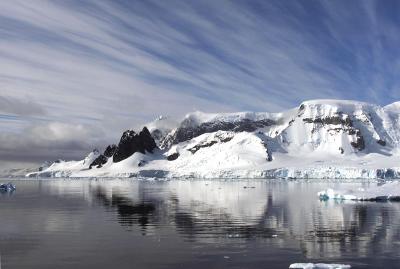 |
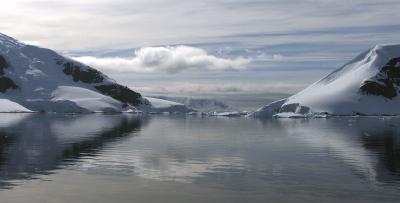 |
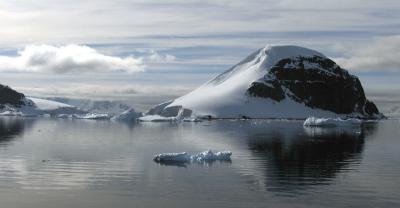 |
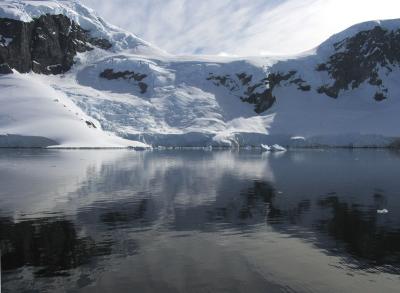 |
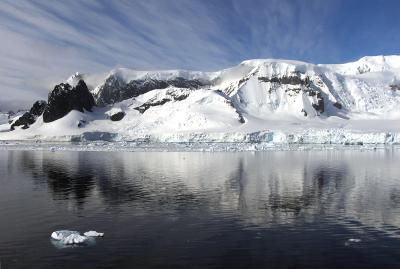 |
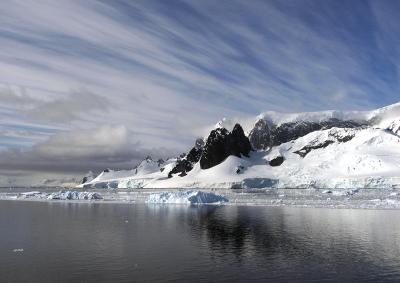 |
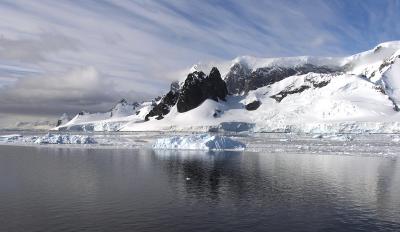 |
 |
 |
 |
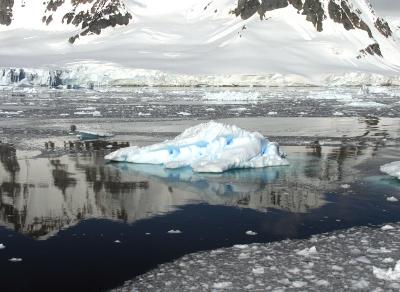 |
 |
 |
 |
 |
 |
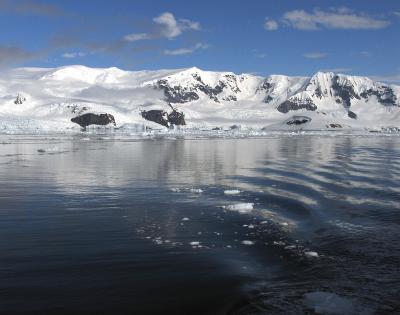 |
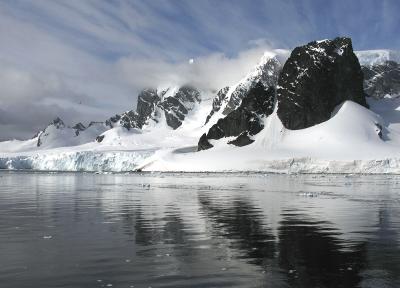 |
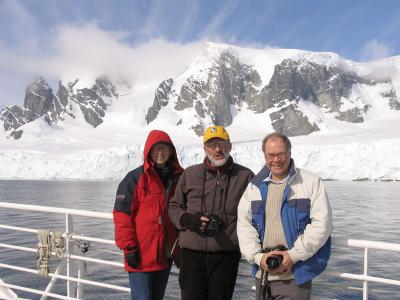
Delirious with the unlimited photograph possibilities around us, we turn the cameras upon ourselves. |

Quite possibly the farthest McConochie south. |
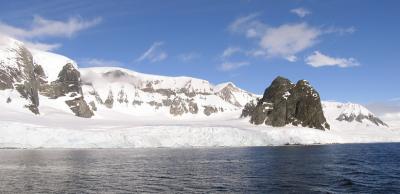 |
 |
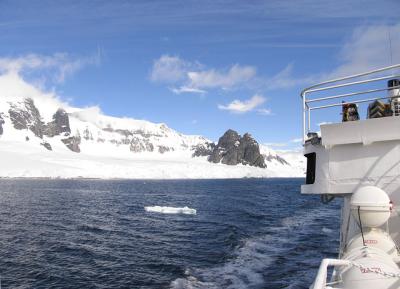
Endeavour picks up speed as we motor north into the Gerlache Strait. |

Scud streaks across the peaks -- a perfect day ends as it began. |

It all makes sense, almost, when you look at the map. |

With the Endeavour northward bound at full ahead, it's time to get off those e-mails. |
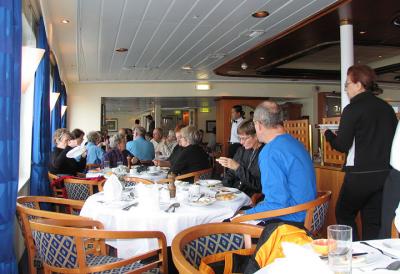 |
 |

Manager Bob Houston and head waiter Gaylord. |
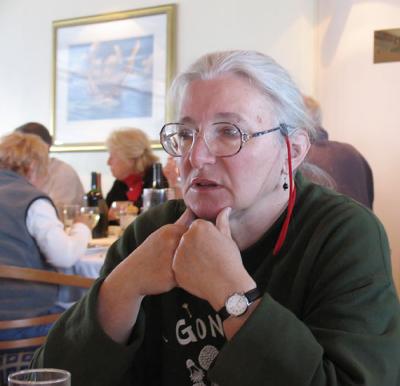
Gillian described this trip as a dream come true. |

Assistant expedition leader Lisa Lagerstrom, dressed for dinner. |
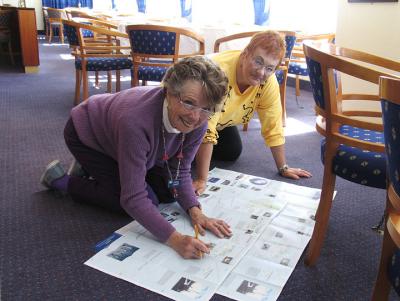
Jackie copies Betsey's notes. |
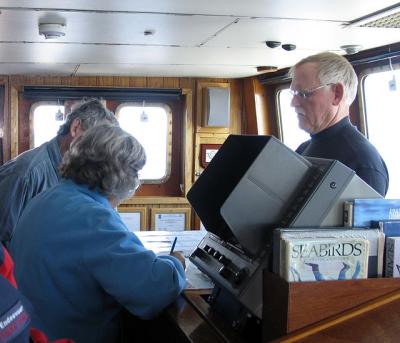
On the bridge, the official map is furiously copied. |
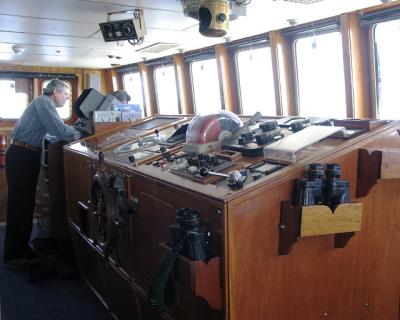 |
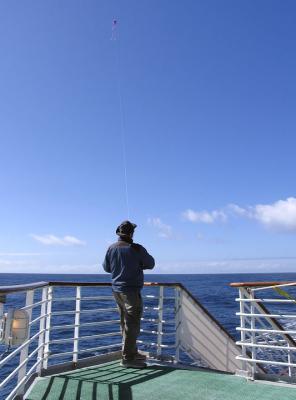
Kite-flying (!) on a balmy day in arguably (and ordinarily) the roughest body of water on the face of the earth. |
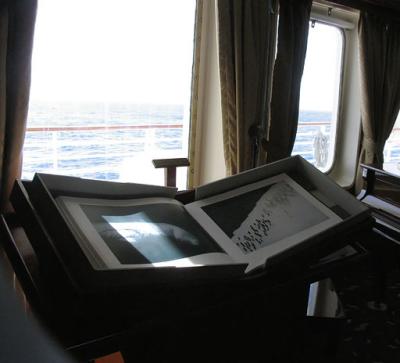 |
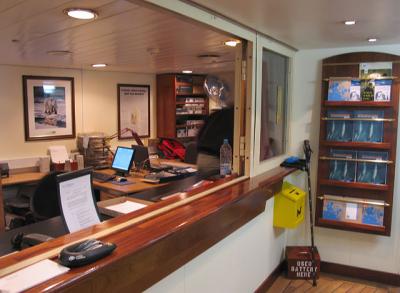 |
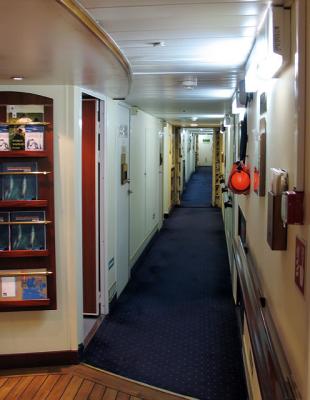 |
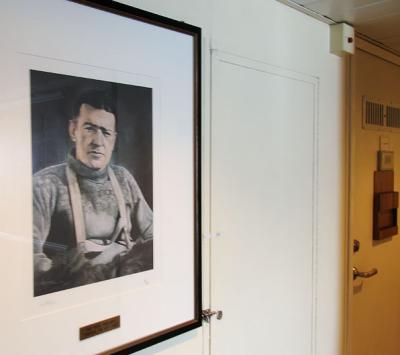
Framed prints of Frank Hurley's photographs of the Shackleton expedition, - |
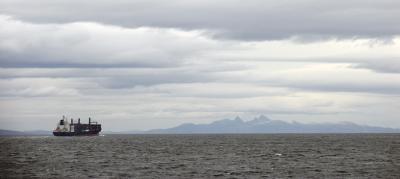
Container ship rounding the Horn. |
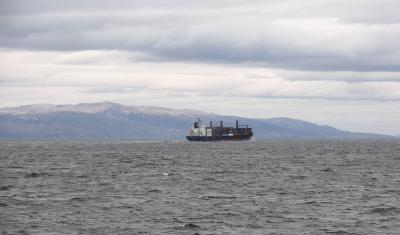 |
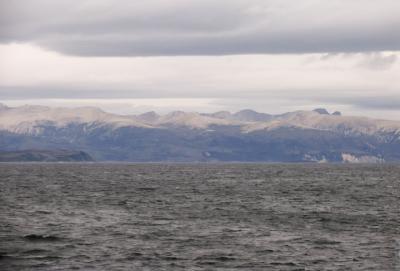
Late afternoon light on Tierra del Fuego |
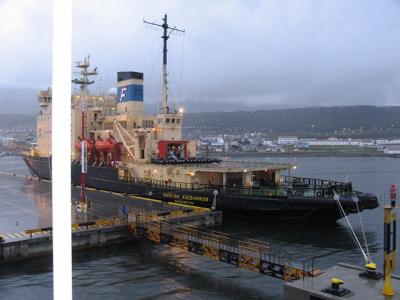
Russian ice-breaker, turned Antarctic cruise ship, across the pier as we make our approach. |
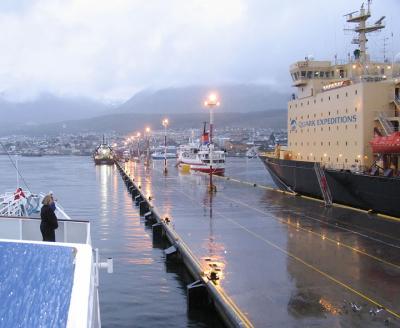 |
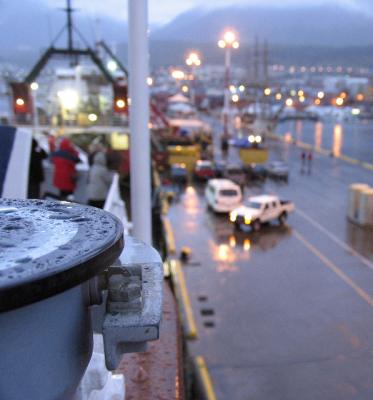 |
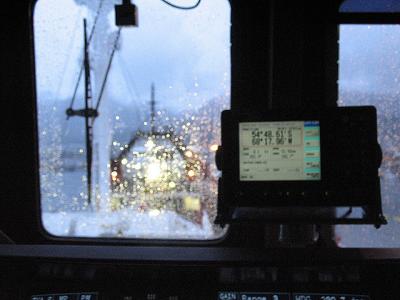
Engines at full stop, Endeavour made fast to the pier, our voyage is at an end. |
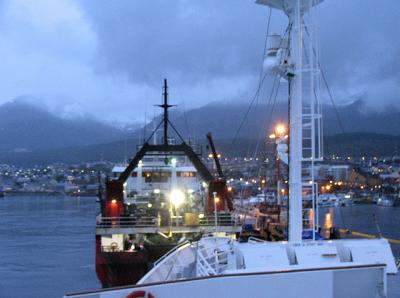 |
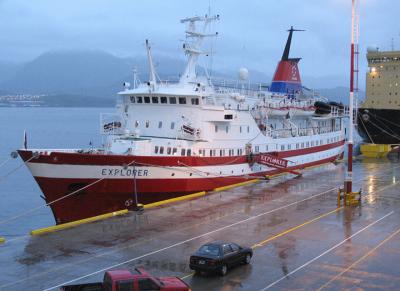
Endeavour's predecessor (the former Lindblad Explorer), now on the bottom of the Bransfield Strait. |
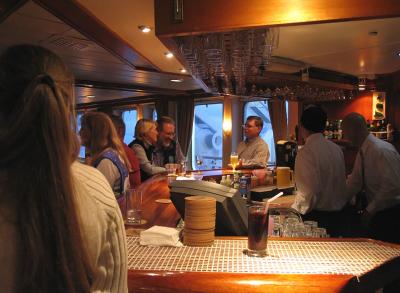
Nobody wants to leave. |
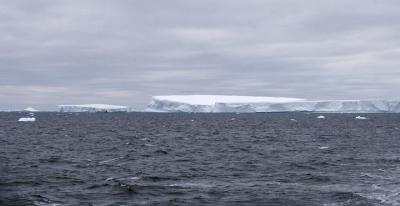
"Once you have been to the white unknown, you can never escape the call of the little voices." (Frank Wild) |
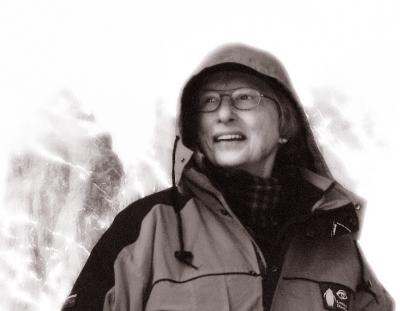
--- McConochie of Antarctica --- |
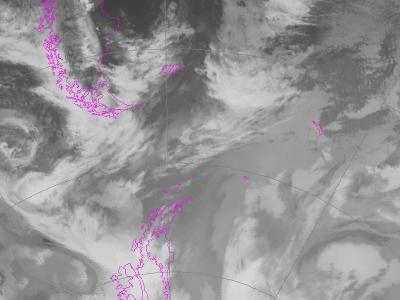
Daily South Atlantic Satellite Images (11/29 - 12/16/04)
|











